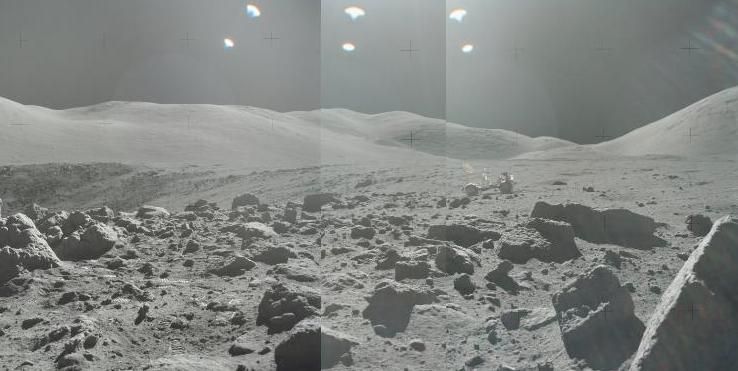 On the photos AS17-145-22160, AS17-145-22161, and AS17-145-22162, the astronaut is sweeping a landscape by turning his camera. What I'm showing here is a panoramic reconstituted with these three photos. On each photo, we find two small sun reflections indicating the direction of the sunlight; the sun is normally just above the upper edge of the photo and aligned with these reflections. The panoramic allows a comparison of these reflections.  Normally the center of the sun would be on the intersection of the lines of reflections, but it would put the sun way too far from these reflections when it should normally be near them; furthermore these lines don't even meet on a common point. 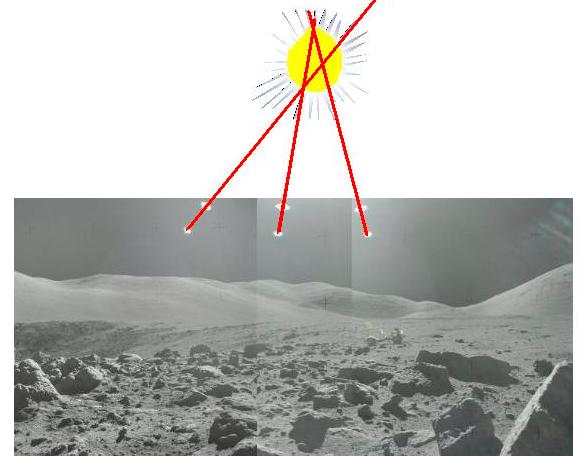 In fact each of the lines of reflections indicates a different position of the light source which is supposed to replace the sun; I have numbered these positions 1 to 3. Between the photos the "sun" has been moved. |
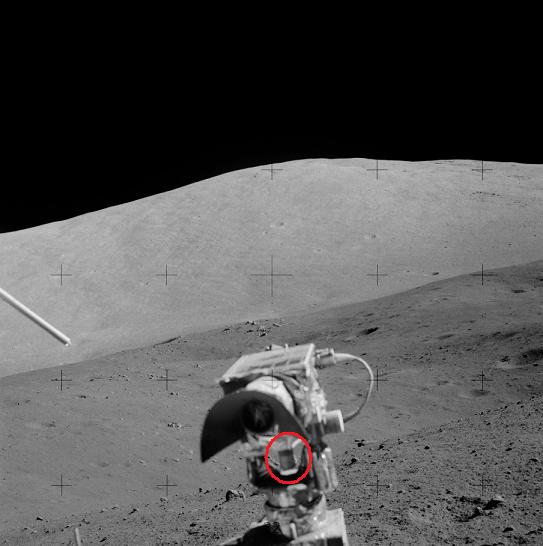 On photo AS17-133-20295, a strange alien object suddenly appears on the camera, an object with a hole (I have circled it in red). |
 And some photos later (AS17-141-21550), the hole of this alien object has even become bigger! |
On this first animation made with the five photos AS17-133-20204 to AS17-133-20208, we see this front camera turn as the rover is circling in the ravine. |
But on this second animation made with four photos AS17-133-20295 to AS17-133-20298, the front camera hardly moves. The rover must go straight. In order to better follow the landscape, I have spotted two perfectly recognizable holes I have circled with two different colors on the four photos. And I have even colored them with two different colors on the four photos. In fact these two holes reveal something that we are going to analyze. I have put two colored boxes on a road representing the two holes. If I back up straight in the same direction as the direction of these two boxes, the direction of these two boxes doesn't change. But if I back up in oblique relatively to the direction of the two boxes, then the direction of these two boxes changes on the photos. Here, in this animation, the direction of the two holes remains the same; that means that the direction of the move of the rover is parallel to the direction of these holes. 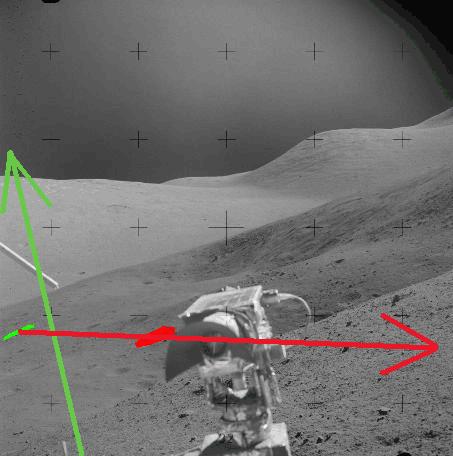 On the photos, we can see the front camera of the rover, and we can see a part of the high gain antenna on the left; the front camera and the high gain antenna are on each side of the front of the rover. Thence the direction of the lengthwise axis of the Rover is approximately along the arrow I drew in green. But we can see that this direction makes an important angle with the direction of the holes (the red arrow) that we know that the rover is moving along. The conclusion is that the rover is moving backwards, but not along its lengthwise axis; it is moving in bias, it is not naturally riding on its wheels but sliding laterally on them... ...In a very improbable trajectory! |
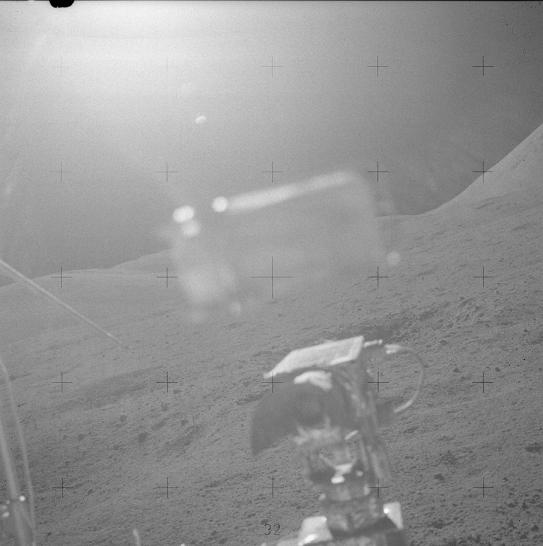 On photo AS17-133-20316, what is this strange object? |
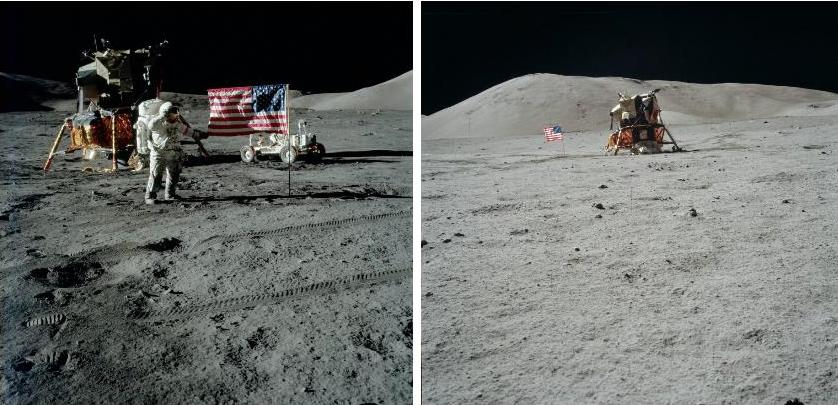 On photos AS17-134-20378 and AS17-134-20508, you can see that the flag is not facing the same side of the LEM. It's a flag which likes to switch sides. |
On this animation made with the photos AS17-134-20378 and AS17-134-20379, there is a double rotation, one around a horizontal axis, and one around a vertical axis; the rotation around the vertical axis is evidenced by the fact that the lem and the rover move relatively to the astronaut and the flag. The problem is that the flag (and the astronaut as well) responds to none of these rotations. Here is the way the flag should change in order to naturally follow the double rotation of the scene. |
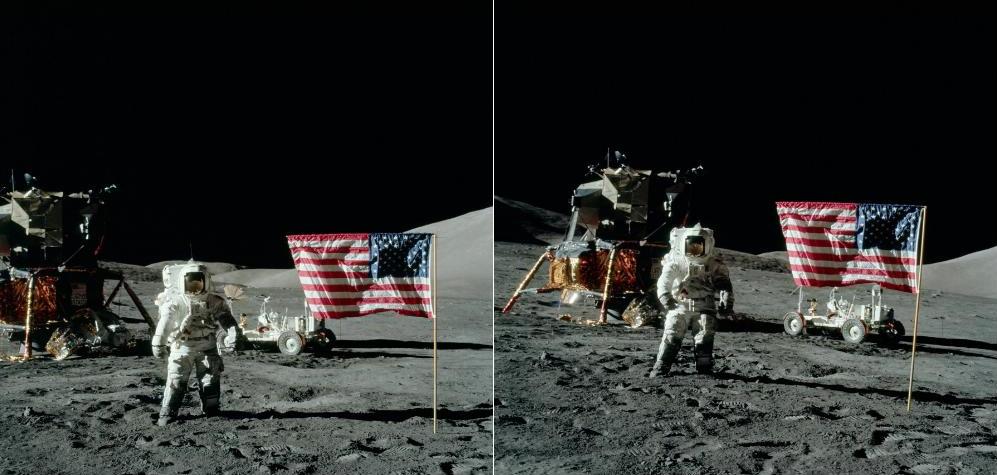 We here have two photos of the astronaut near the flag (AS17-134-20381 and AS17-134-20382). Between the two photos, the photographer has moved on the right; this is visible for the flag has moved on the left relatively to rover and the Lem.  On this pair of photos of a bike taken before cars, on the second photo I have moved on the right. This is visible for the bike has moved on the left relatively to the cars which are behind. On the second photo the bike shows an optical clockwise rotation caused by my lateral move on the right. 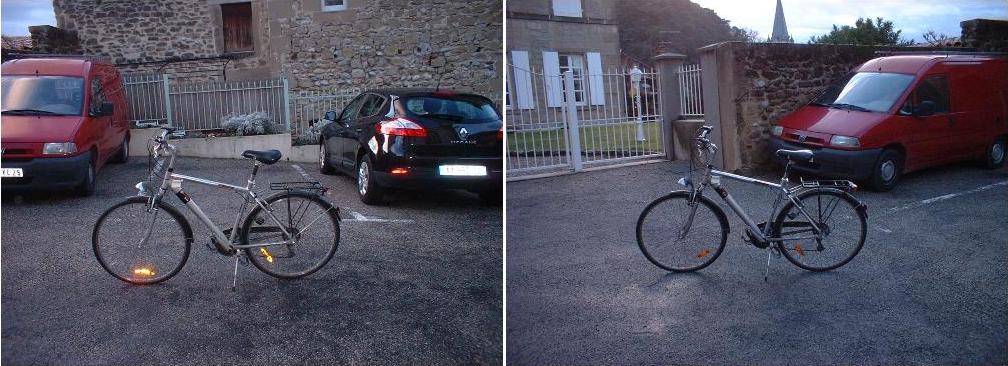 Now I can manually apply an counterclockwise rotation to the bike in order to compensate the optical clockwise rotation, so that the bike has the same orientation on the two photos.  On this double view, we should see an optical rotation of the flag on the second photo in reason of the move on the right of the photographer. 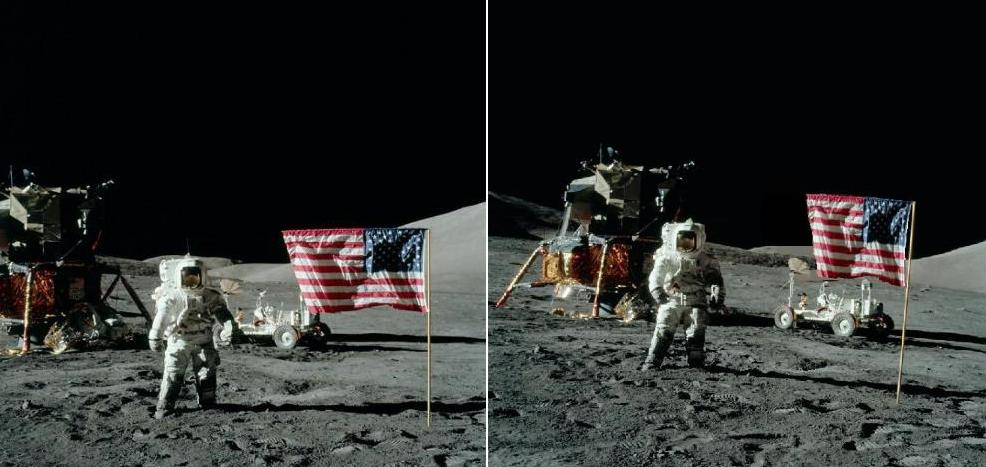 In fact, we should see an optical clockwise rotation of the flag on the second photo like on this view I corrected.  The flag could only keep its initial orientation on the second photo if a manual counterclockwise rotation was applied to it in order to compensate the optical clockwise rotation caused by the lateral move of the photographer. |
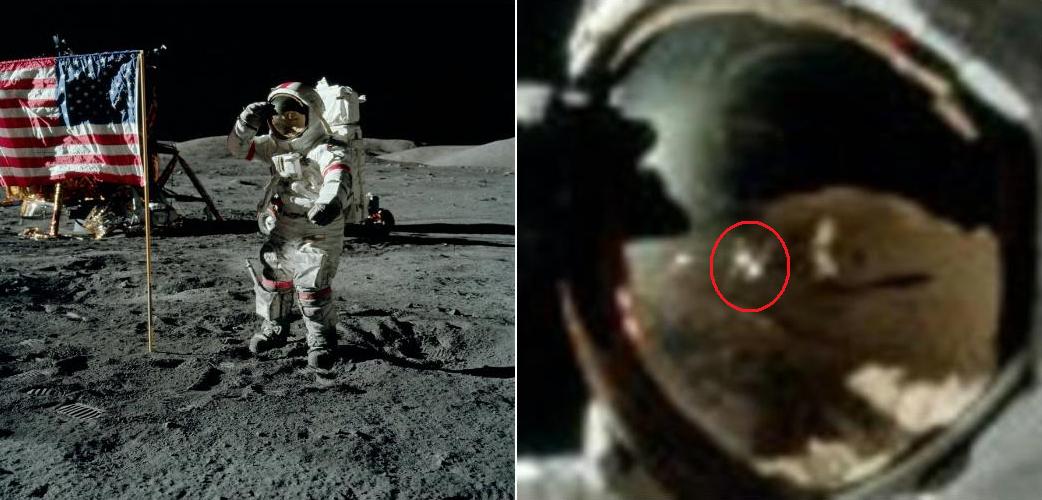 On photo AS17-134-20380, we see a white object between the photographer and the flag in the visor of the astronaut who is saluting the flag (I have circled it in red) ...But we don't see it on the photo itself! |
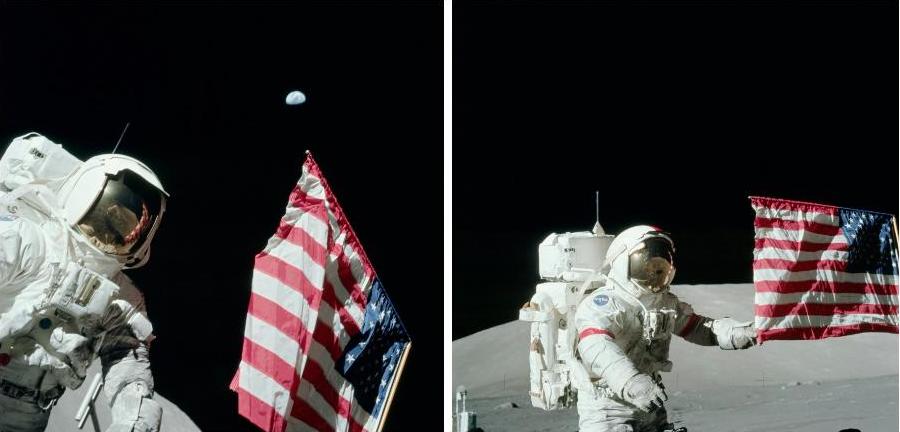 The photos AS17-134-20384 and AS17-134-20385 present two views of the two astronauts near the flag. 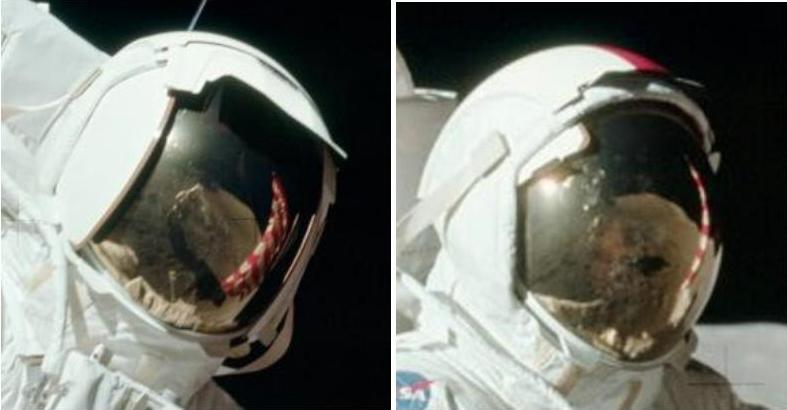 But if we take a better look at the helmets on the two photos, we can see they are very different. Why are their helmets so different? |
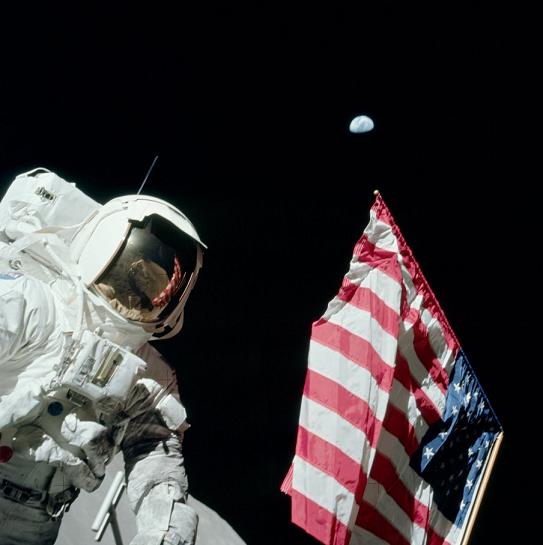 On this photo, AS17-134-20384, Schmitt and the flag are taken with the camera placed low and looking up. In order to take this photo, the other astronaut had not only to kneel down, but also, as his camera was strapped to his chest, to bend his back to allow his camera to look up. 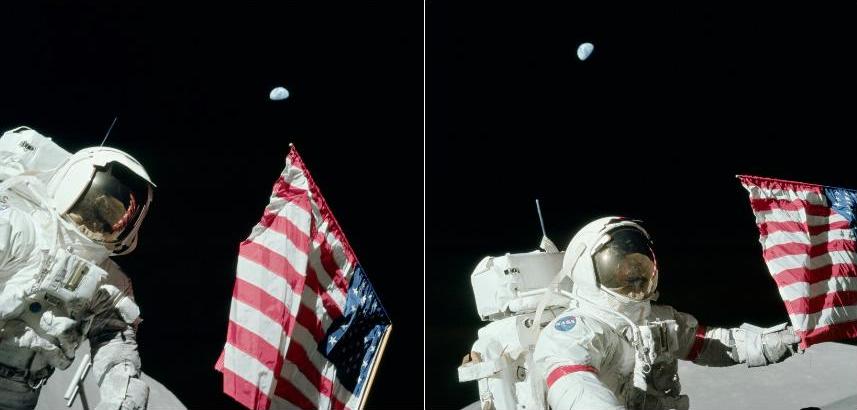 If we compare the photo AS17-134-20384 (left) with the photo AS17-134-20387, we might have the feeling that the earth is not above the same point of the hill. In fact, it is, for the photo AS17-134-20384 appears rotated of 45° counterclockwise. 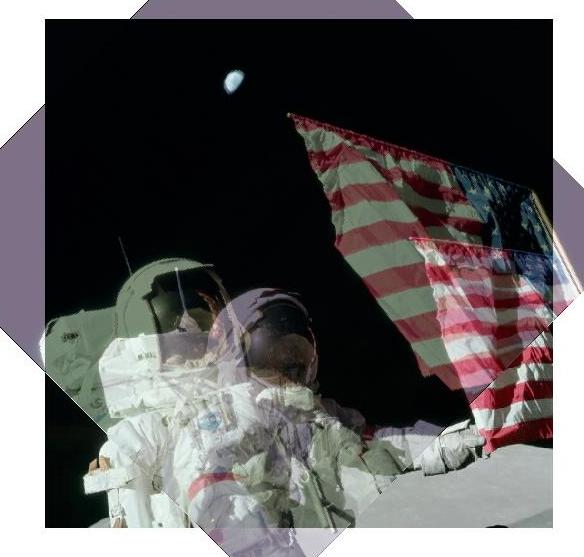 Indeed, if we make a superposition of the photo AS17-134-20387 with the photo AS17-134-20384 rotated 45° counterclockwise, we can see that we can have a superposition of both the earth and the hill, which confirms the 45° counterclockwise rotation of the photo AS17-134-20384. That means that the photographer has rotated his camera 45° clockwise. 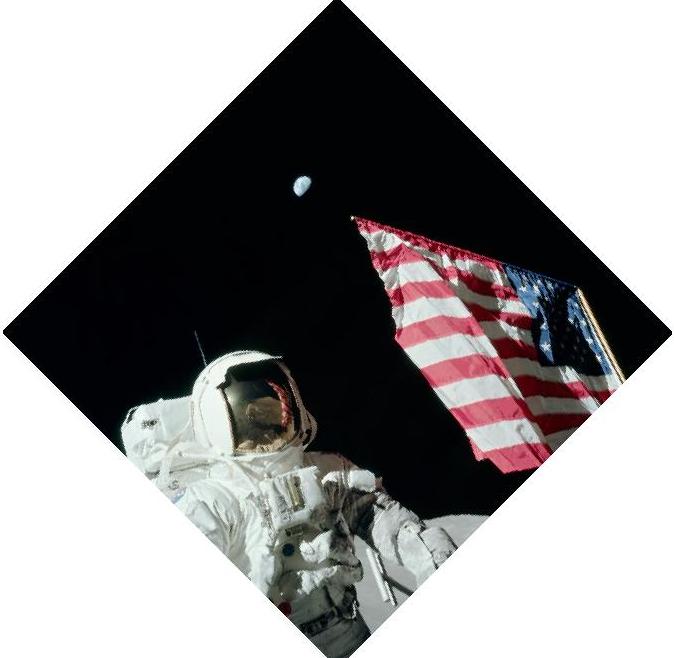 So, if we rotate the photo AS17-134-20384 counterclockwise, we see what we would have seen if the photographer had oriented his camera normally. 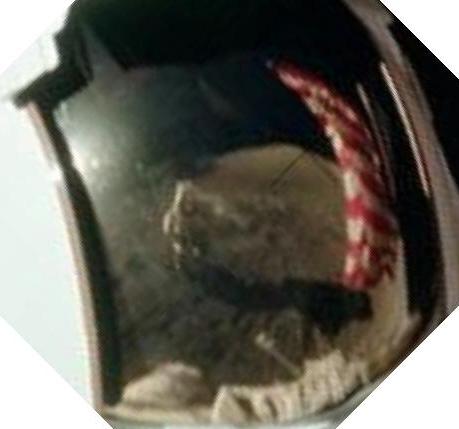 And if we make a close-up of the visor rotated 45° counterclockwise, we can see what it looks like normally. What do we see in this visor? 1) The visor is in profile relatively to the photographer, so the reflection of the photographer must also be in profile in the visor. But it's not the case: the photographer is not seen in profile in the visor, he seems to be seen facing the visor. 2) The angle of vision of the camera is very clear on the photo; the photographer is kneeling (this is not a supposition, since we can see him kneeling on the visor), and he has to rotate his camera up (around the horizontal axis) to make it look up; for that purpose the photographer would have to bend his back backwards. But it's not the case: in the reflection of the visor, the photographer is in a straight position, and his camera is oriented in such a way that all it could take is the legs of the astronaut. 3) Finally, we have seen that the astronaut had to swing his body on the right in order to turn his camera 45° clockwise; but it's not the case at all, he is holding his body normally, like he was taking the photo not rotated. So, in conclusion: Triple incorrect orientation of the photographer totally preventing him from taking the photo we see. 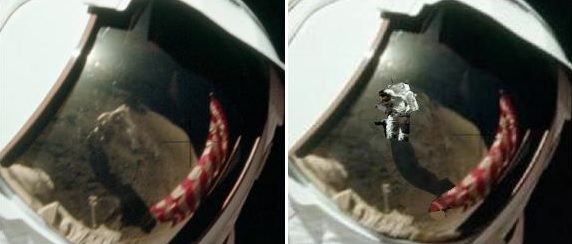 I have corrected the orientation of the photographer to give an idea of what he should have looked like in this visor. In my photocomposition, the photographer is seen in profile and bending his back backwards like he should, and also swinging his body on the right so the photo he takes appears rotated. Well, I know my photocomposition is not perfect (I have used an astronaut I have cut from another Apollo photo), but it's just to give an idea. |
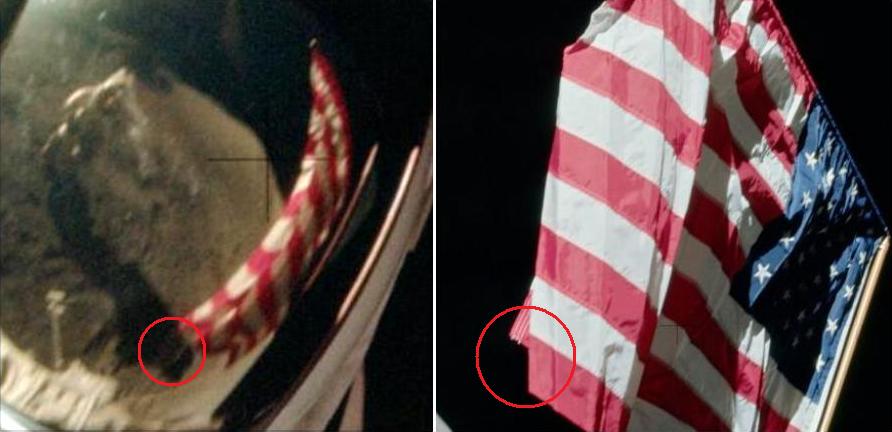 On the same photo, I also show that the photographer's shadow cuts the lower end of the flag in the visor's reflection, but not on the photo. 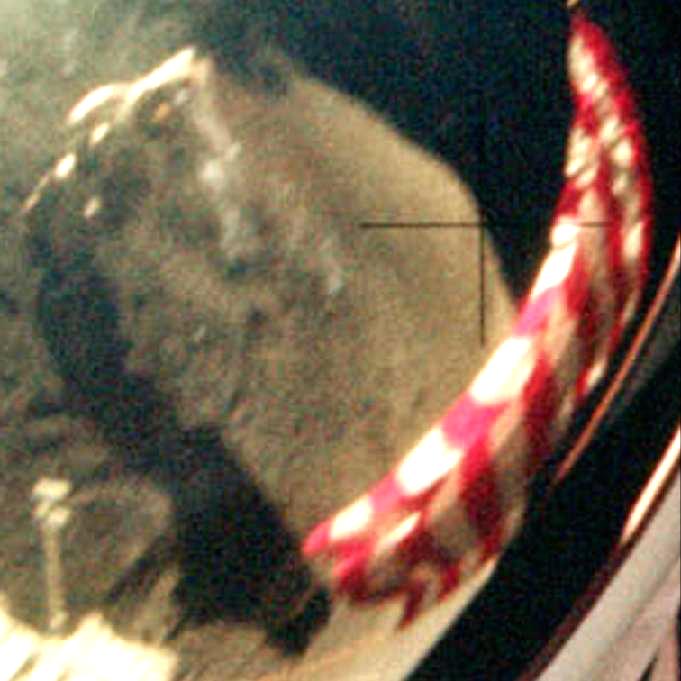 Now, if you don't see it, I show you a close-up with an increase of brightness which should allow you to see it. |
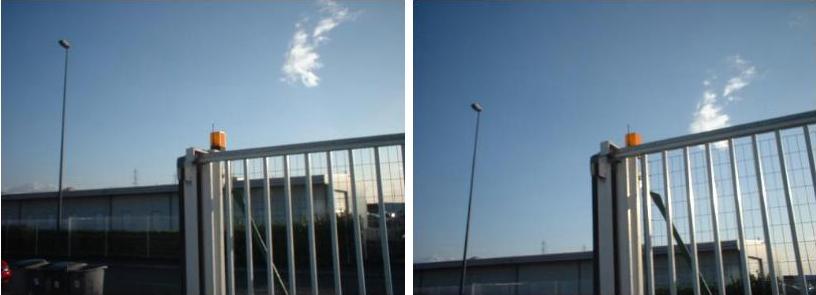 Before showing the next inconsistency, I first show a real example illustrating the problem. On the photo of the left, I am standing up and I am taking a close orange lamp, centering it on the photo; in the background, we see a street lamp which appears high on the photo. On the photo of the right, I have bent down, and I orient my camera to have the orange lamp centered on the photo again; as I am now lower, I have to turn my camera upward to have the orange lamp centered on the photo; and we can see that this move of the camera makes the street lamp in the background go down on the photo. Does this have a relationship with Apollo? Absolutely, as I am going to show you. 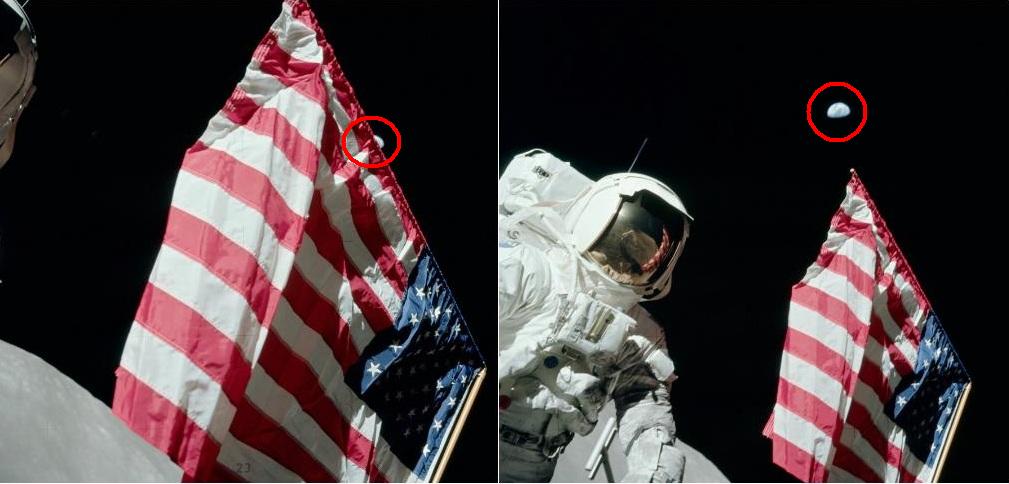 This double view shows the photo AS17-134-20383 (left) and AS17-134-20384 (right) of the mission Apollo 17. On the photo of the left, the photographer is still standing up. On the photo of the right, he has knelt down (this is not just a supposition, for we can see him kneeling in the reflection of the visor), and so, to have the astronaut and the flag again on the photo, he had to turn his camera upward, otherwise all he could have taken is the legs of the astronaut and the flagpole. On the photo of the left, we can see the earth I have circled; it is partially hidden by the flag, but still visible. On the photo of the right, we can also see it, but, what's surprising is that, instead of going down on the photo (like the street lamp on my example), it has gone up instead. This is an incontestable incoherence.  I have corrected the position of the earth on the second photo to put it lower; so that it would not be hidden by the flag, I have moved it on the left; in reality, there are chances that it would be hidden by the flag on the second photo. |
 On these three photos (AS17-134-20390, AS17-134-20391, and AS17-134-20393), the rover is turning counterclockwise on the lunar ground. Between the first and the second photo, we can see that the rover has a little turned counterclockwise; consequently the sun has turned a little clockwise around the high gain antenna, what we can effectively observe. On the third photo, the way the hill we see is positioned relatively to the hills of the two previous photos, the rover has turned approximately a quarter of a turn counterclockwise. Consequently the sun should have turned a quarter of a turn clockwise around the high gain antenna..but it's the converse, it has turned a quarter of a turn counterclockwise instead. We could also say that the sun has turned three quarters of a turn clockwise around the high gain antenna, but it's too much, the rover hasn't turned as much. |
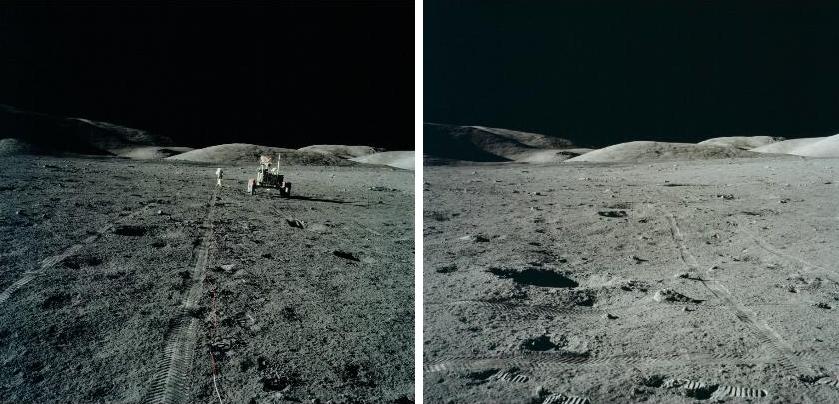 On photos AS17-134-20436 and AS17-134-20437, we see two views of a lunar plain. I have colored with different colors recognizable artifacts of this plain, and when we play an animation with the two photos, these artifacts seem to behave incoherently. |
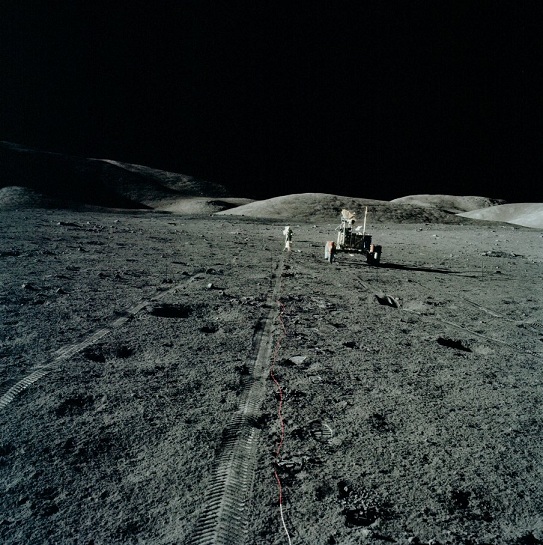 On the photo AS17-134-20436, We can see the lunar rover in the distance, the SEP transmitter, and, behind the SEP transmitter, the astronaut. 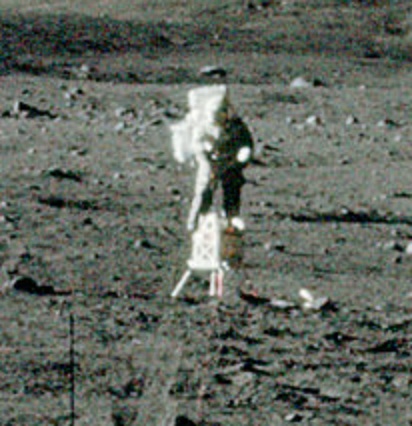 The astronaut does not look big relatively to the SEP transmitter. 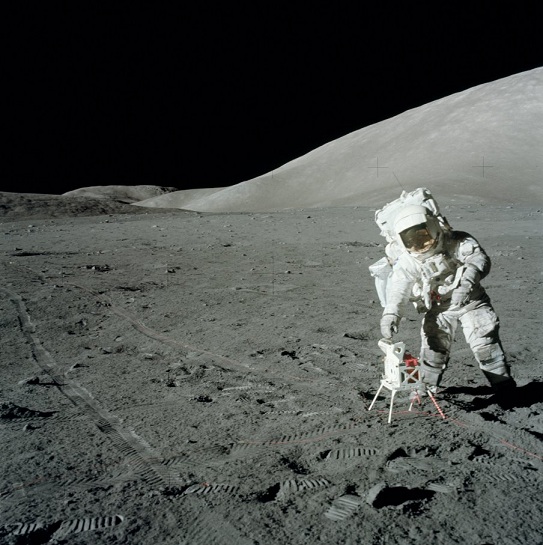 On this photo (AS17-134-20438), we can see that the astronaut is much bigger than the SEP transmitter, consistently bigger than he appears on the previous photo.  We might think that, if the astronaut does not look very big relatively to the SEP transmitter, it is because he is farther away. 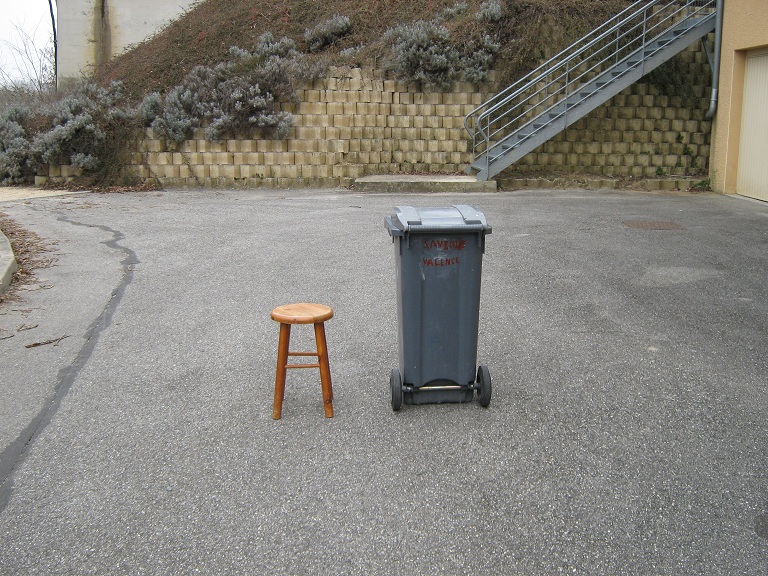 On this photo, we can see two objects I use for my demonstration: A waste bin and a stool; the waste bin is almost twice taller than the stool. 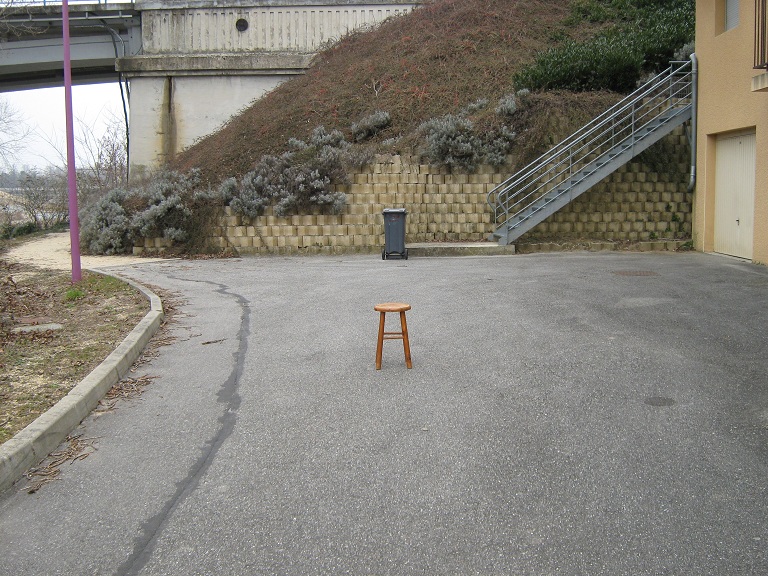 On this photo, I have placed the waste bin in the background, and the stool closer to me. Because the waste bin is farther than the stool, it looks almost as small as the stool. 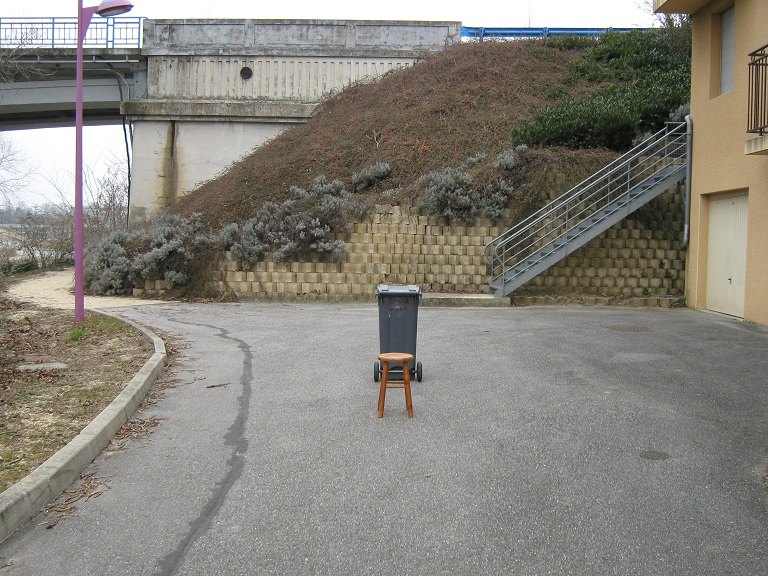 Now, I have placed the waste bin so that its bottom comes under the top of the stool; their respective distances to me are now not very different. The result is that the relative sizes of the waste bin and the stool are almost the same as when they are at the same distance from the photographer.  If you observe the feet of the astronaut, you can see that they come under the top of the SEP transmitter; that means that the astronaut is quite close to the SEP transmitter; the distance between the SEP transmitter and the astronaut is quite small relatively to the distance between the photographer and the SEP transmitter; it also means that the relative sizes of the astronaut and the SEP transmitter are quite close to the ones they have when they are at the same distance from the photographer (like in the photo AS17-134-20438). 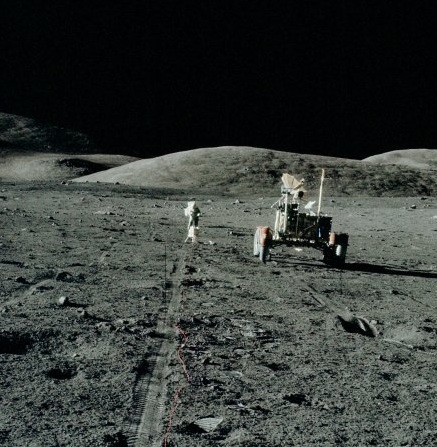 That means that the astronaut should not appear with this size on the photo AS17-134-20436 (this is not the whole photo, but a cropped part of it)... 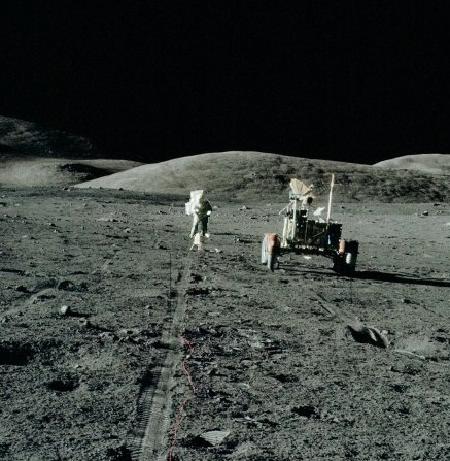 ...But rather with this size instead, a size more compatible with his relative size to the SEP transmitter. 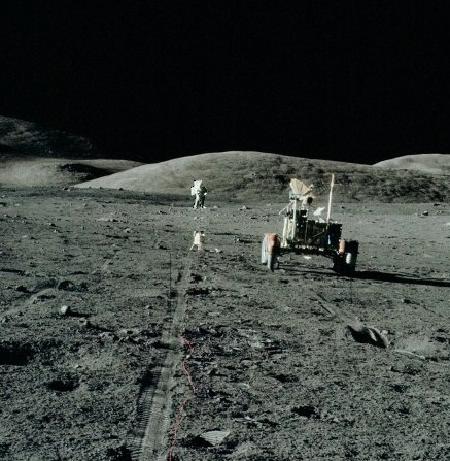 The astronaut would have this size, if he effectively was farther from the SEP transmitter, like on this modified photo on which we can see that there is a real interval between the astronaut and the SEP transmitter. 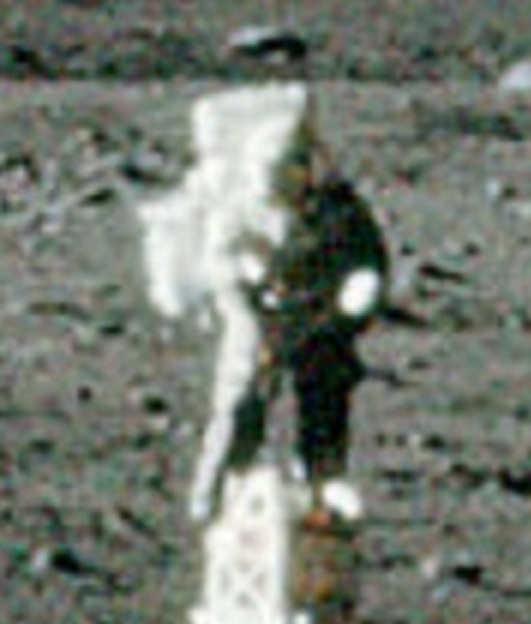 And, if we attentively look at the astronaut, we can see something strange: Almost half of his backpack is missing on his right (his left relatively to himself); yet, he is obviously facing the camera, and the bag we see hooked to his backpack on the left indicates that the backpack is not seen in profile. |
 On this photo, AS17-134-20444, we see lit parts on the wheel's shadow due to the open mesh wire of the tire tread....  We can see the other wheel on the other side of the rover, I have circled in red. It is the wheel itself, and not its shadow, because we can see how the shadows are oriented, from right to left, so it can't be its shadow. But we don't see this wheel correctly, we see it frontally, in the direction it rides, instead of seeing it on its side. |
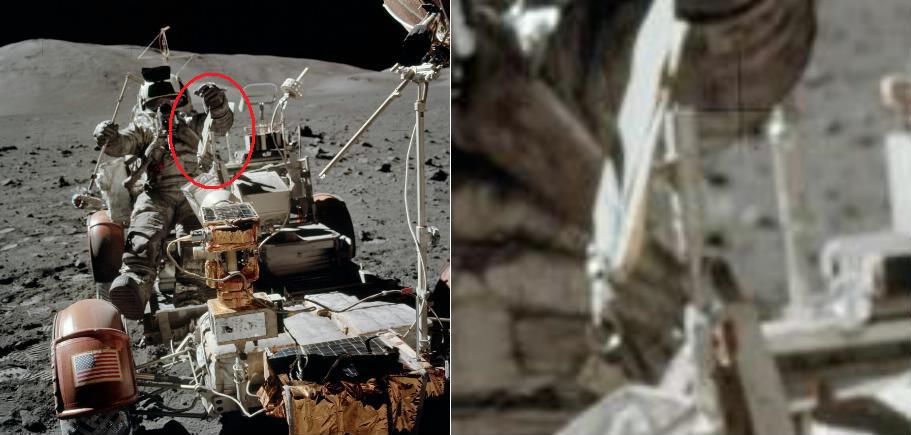 On photo AS17-134-20453, the astronaut makes me think of a fisherman. What he is holding in his right hand makes me think of a fishing rod, so I wanted to check what he was holding in his left hand. Well, on the close-up, it really seems to be a fish! 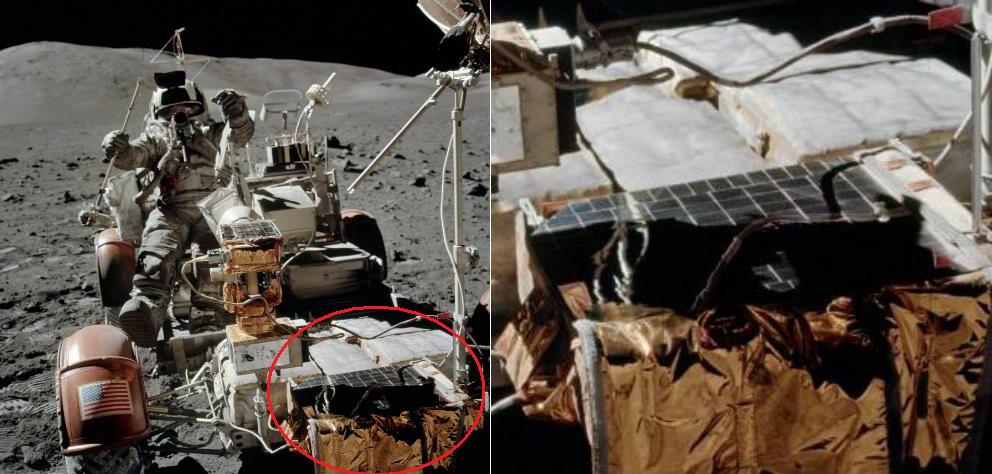 And the solar battery seems seriously damaged; I highly doubt this is normal. The astronaut might have some power problems! 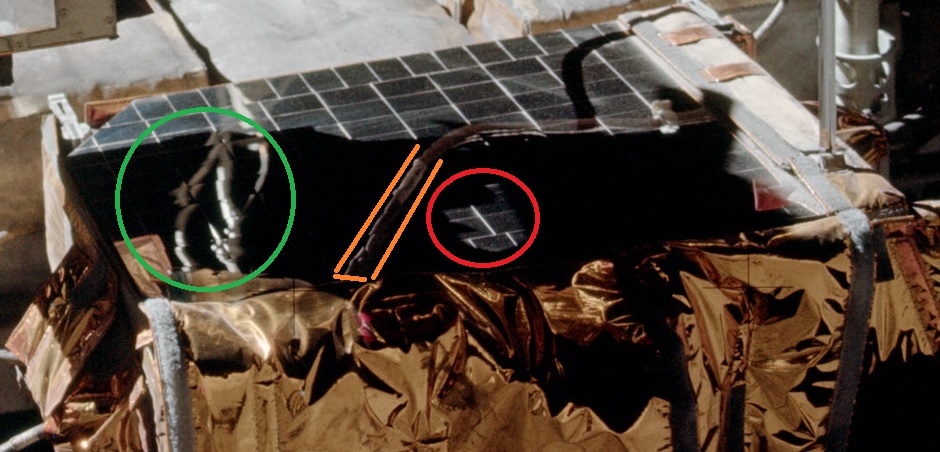 Somebody has said that in fact the battery was not damaged, but that it was just shaded by what is on its left. In that case, I would want to know why the items I have contoured are not shaded too! |
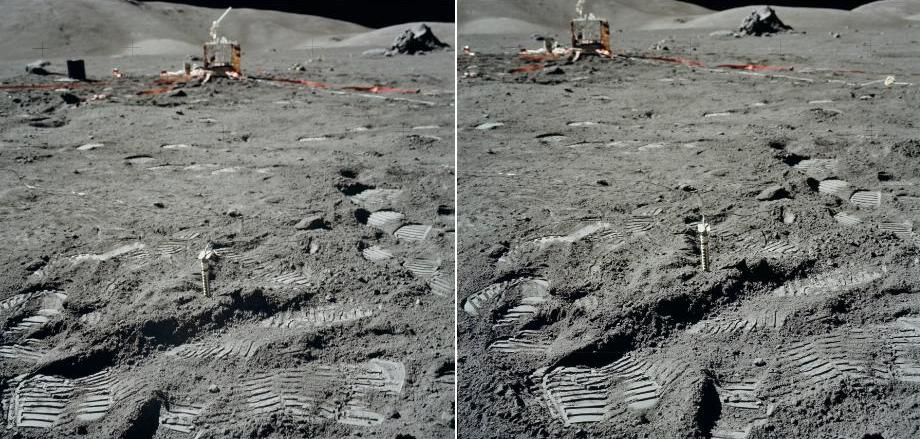 The photos AS17-134-20493 and AS17-134-20494 are two views of the same scene. Between the two views, the photographer has moved on the left and turned his camera on the right; it explains what we see on the next photo (AS17-134-20494): The artefacts which are closer to the photographer have moved on the right relatively to those which are farther. 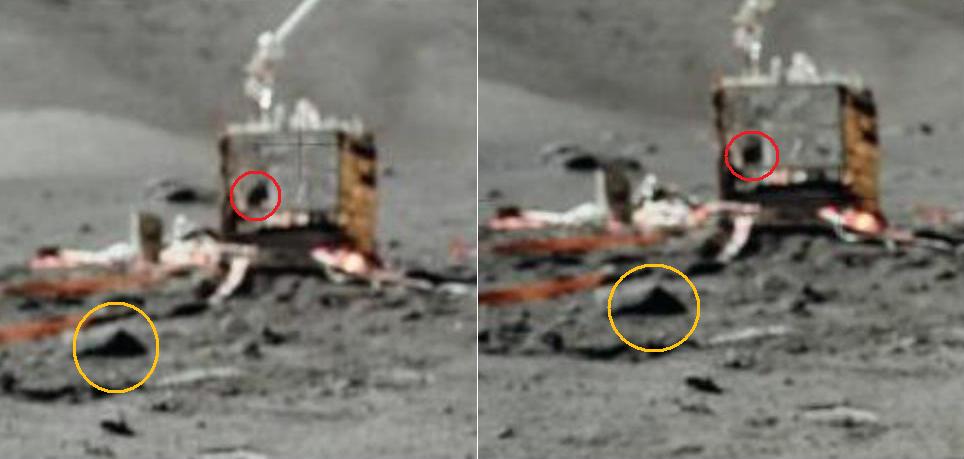 Before the ALSEP, there is a black rock (circled in orange) of which we see a reflection (circled in red) on the ALSEP. On the second view, because of the move on the left of the photographer, the rock (closer to the photographer) has moved on the right relatively to the ALSEP; its reflection on the ALSEP should also have moved, but it's still at the same place on the left of the ALSEP! 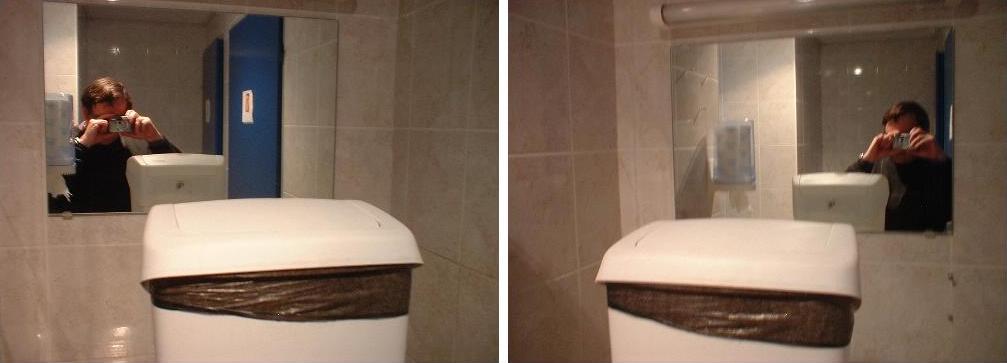 Here I take an object (a waste bin), I place it before a mirror, and I move along it: The bin moves relatively to me, but its reflection also moves relatively to the mirror, and you can see that it moves toward the opposite direction; when the bin is on my right, its reflection is closer to the left edge of the mirror; and when the dust is on my left, its reflection is closer to the right edge of the mirror. When the black object moved on the right because of the photographer's move, its reflection on the ALSEP should have moved the other way; as it already was on the extreme left of the ALSEP, it should in fact have disappeared from the ALSEP. |
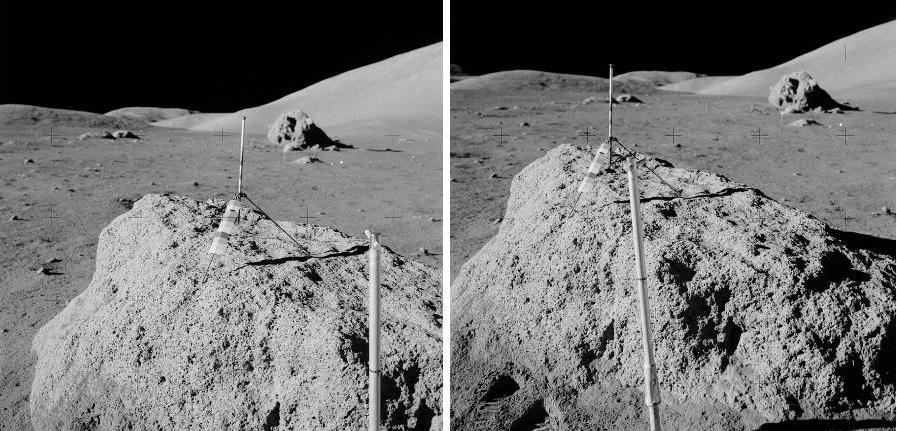 On the photos AS17-136-20714 and AS17-136-20715, we have two views of a big rock in the foreground, and other rocks and the hills in the background. Between the two views, the photographer has moved back and on the right, and also turned his camera on the left and down. What we see on the two views is coherent with these actions of the photographer. |
 But if we look closely at the handle of the pole in the close foreground, we can see that on the first photo it's plastic, and on the second one it's metallic. 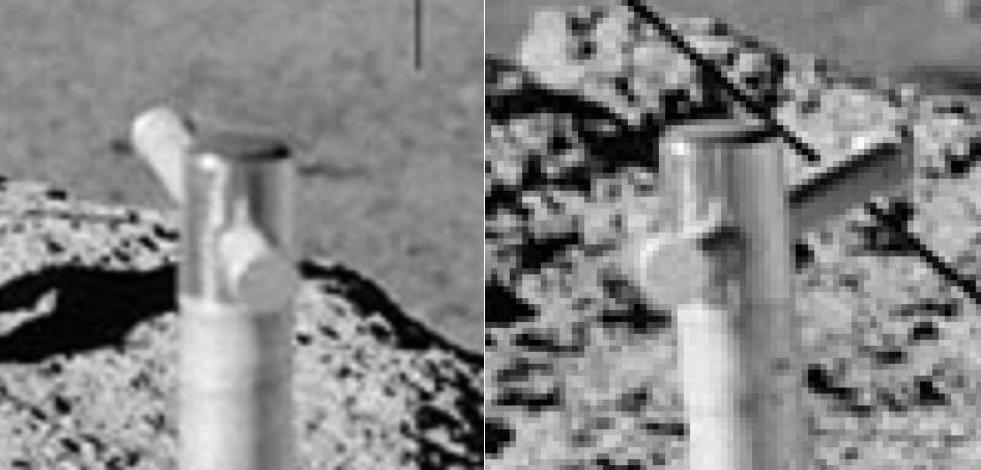 May be on this zoom you can better see the difference between the two cylinders! |
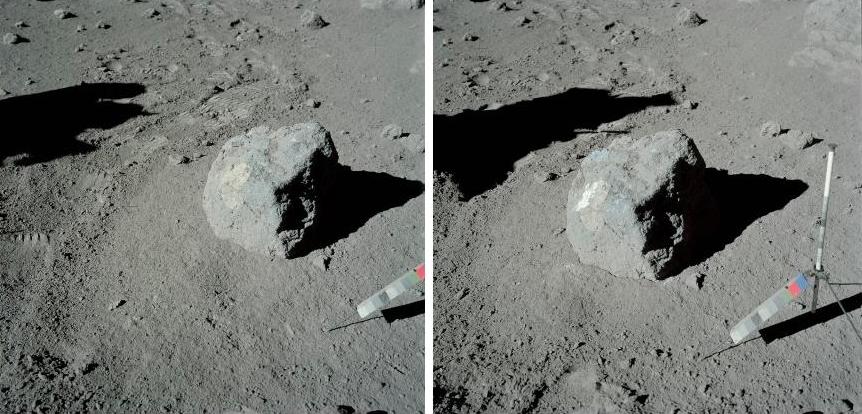 Between photos AS17-137-20694 and AS17-137-20695, the shadow of the astronaut changes drastically; the second shadow is especially weird. It can only be the shadow of an astronaut, for, if it was the one of a static object, it would be the same on both photos. It might be a mix of the shadow of a static object and the one of an astronaut, but even in that case it remains weird. The parts which change would belong to the astronaut, and these parts are incoherent. |
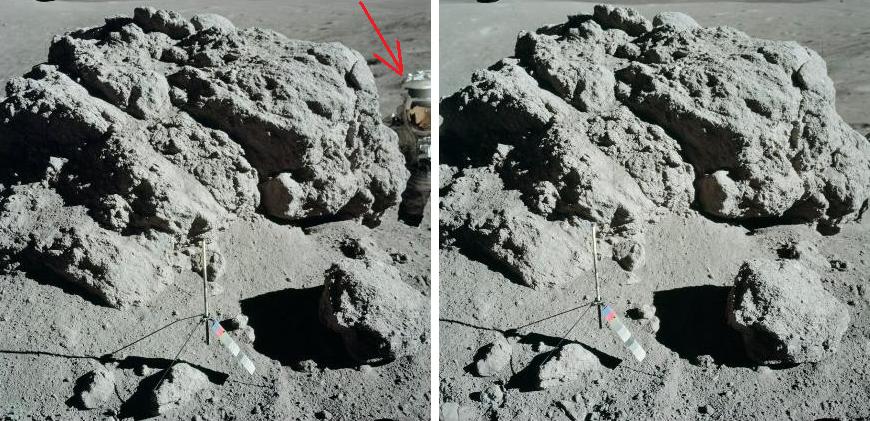 On photos AS17-137-20900 and AS17-137-20901, we see two views of a rock. But what's interesting is what is on the right side of this rock. On the first photo we see appear an astronaut's head, with something funny over his helmet, and on the second photo, this astronaut disappears. 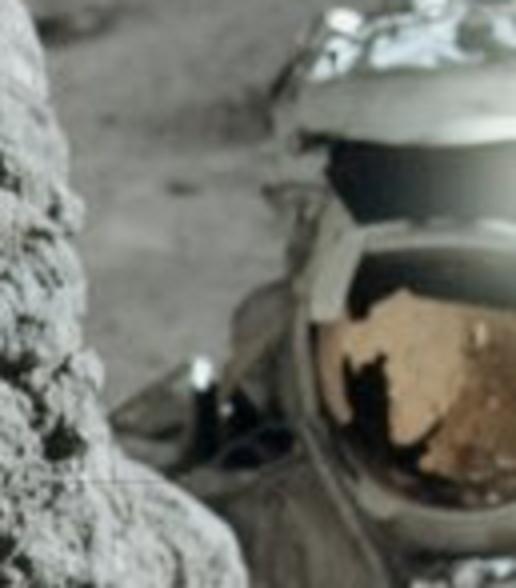 On this close-up, you can better see the strange head of the astronaut, with the strange thing he has over his helmet, which looks like an university doctor's toque. What we see in the visor of the astronaut is also interesting: 1) We can see the reflection of the photographer on the center of the visor; yet, as the astronaut's head is on the extreme right of the photo, the reflection of the photographer should appear on the left of the visor, and not its center. 2) See how the shadows are oriented on the photo: We should not see the reflection of the shadow of the big rock on the visor.  And there is a very weird thing just under the astronaut's bust on the first photo. If we play an animation with these two photos, it makes a funny effect. |
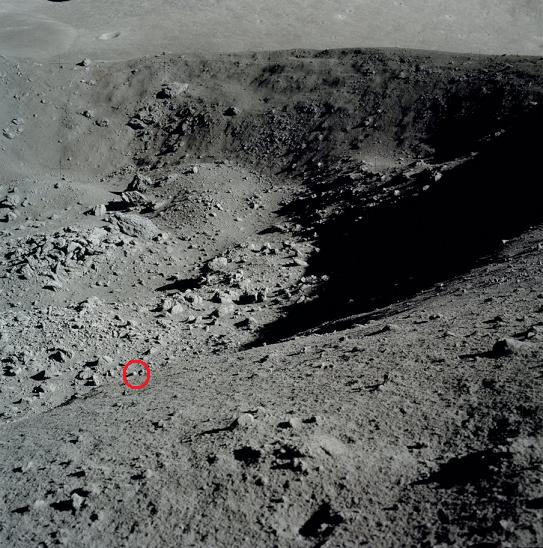 Between photos AS17-137-20992 and AS17-137-20993, don't ask me why, but I felt I would find something different between the two. And I found it, it's in the zone I have circled in red. 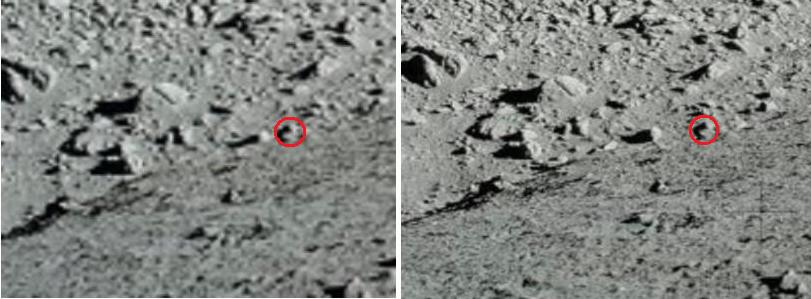 If we take a close-up of this zone on the two photos, we see what it is. You see the little rock I have circled in red, it moves away from the rock it was close to on the first photo. |
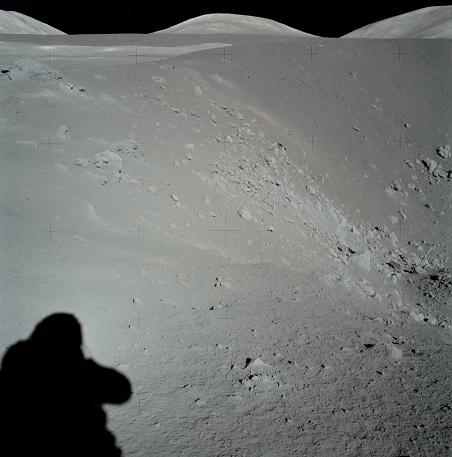 This is the photo A17-137-21008 of Apollo 17. We see the shadow of the astronaut like it was projected on a flat ground; but, in fact, he is on the edge of a ravine, so his shadow should go down the ravine, and look completely different. |
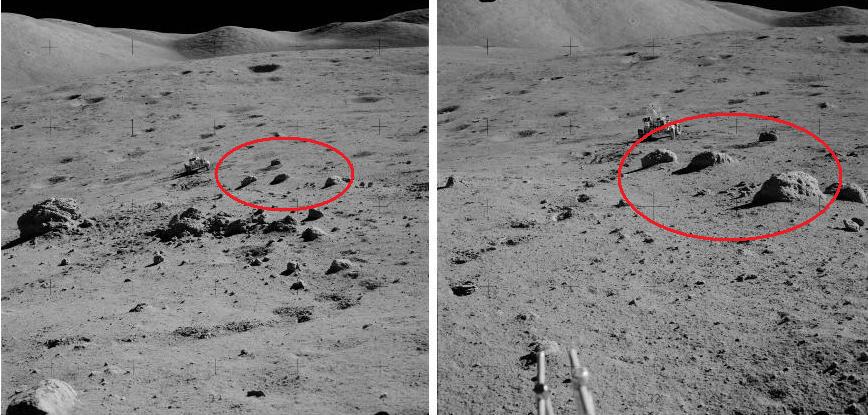 On the photo AS17-138-21039 (on the left), we see three rocks in the distance. On the photo AS17-138-21048 (on the right), we see them again, but closer, and under a different perspective. 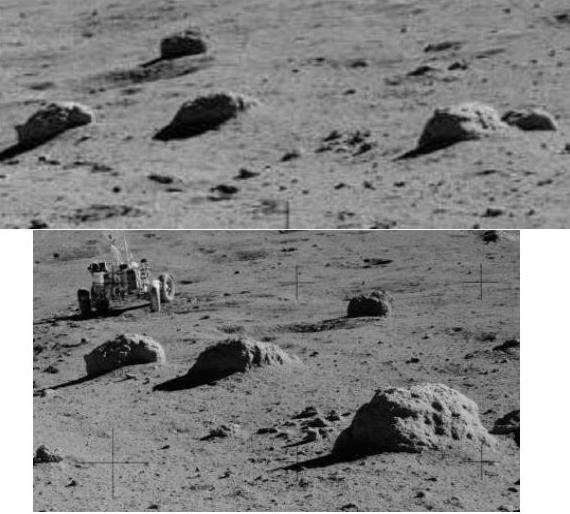 If we compare a close-up of the rocks on the first view with the rocks of the second view, we can see that the artifacts which are near them are different. If we make an animation with the two views of the three rocks, it makes a funny impression. |
 On photos AS17-139-21203 and AS17-139-21204, we have two large views of a lunar landscape with the LEM in the distance. Something told me I would find something different on the two photos, and you know what? I found it! It's on the zone I have circled in red.  On the close-ups, you can see that there is a black spot which has moved from one hill to the other. |
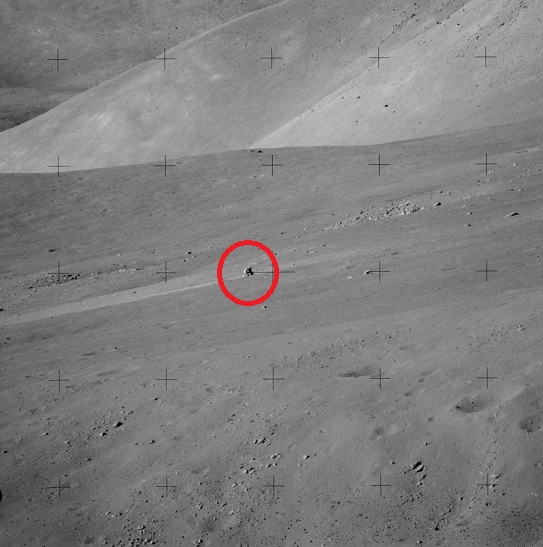 In the center of the photo AS17-139-21203, we can identify the lunar module. 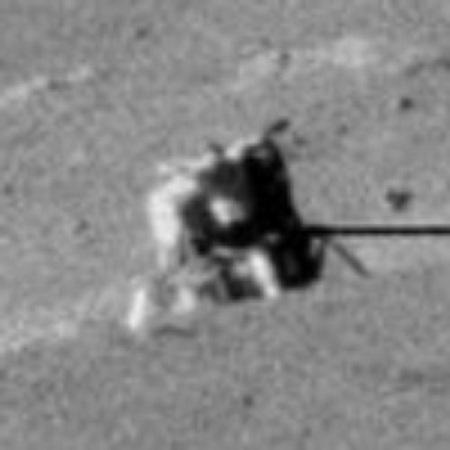 And this close-up shows that it is undeniably the lunar module! 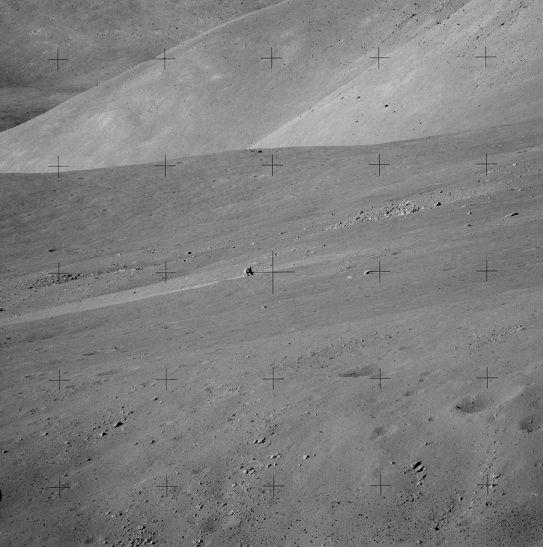 So, what we see down there is the lunar plain where the lunar module landed. This photo is obviously taken from a height... ...And, as the astronaut could not fly in the air by his own means...  ...This photo could only be taken from one of the hills surrounding the lunar module. And the hills we see on the top of the photo are hills opposed to the hill that the astronaut is taking the photo from. As we see these hills from quite a distance, we should also see these hills when the astronaut is turning all around to take all the hills around the lunar module, and they should even appear still bigger. Yet, we can't identify the hills we see on the photo AS17-139-21203 among any hill of the panoramic. I have tried to localize these hills on other photos of the mission, but I couldn't. It is obvious that these hills can only be a small detail of the hills which are around the lunar module.  You could say that the fact that these hills appear quite big, when they should appear much smaller instead, could be explained by the fact that the astronaut is currently zooming in, but, to see these hills that big, the astronaut would have to zoom in a way he couldn't. Furthermore, the angle of view would be so much reduced, that it would not be possible to have the lunar module on the photo. In other words, this photo is incompatible with the other photos of the mission! |
On this animation made with the photos AS17-140-21390 and AS17-140-21391, the astronaut moves his body; but what's funny is that the landscape and the rover move with him. Observe the rotation movement of the pole of the umbrella antenna which is abnormal, since the objects don't move relatively to each other, which shows that the astronaut has not moved. There is still something weird to notice about this animation: The footprint that I have colored in yellow becomes partially covered by the astronaut's shadow on the second shot; the covered part should logically become shadowed, but it remains lit...like it was retro-lit! |
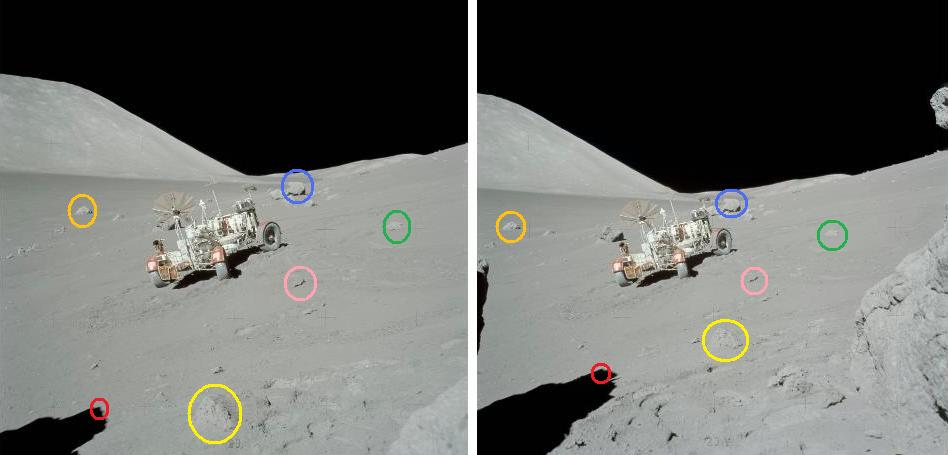 On photos AS17-140-21409 and AS17-140-21412, we have two different views of the rover. I have circled with different corresponding colors artifacts which are perfectly recognizable on the two views. 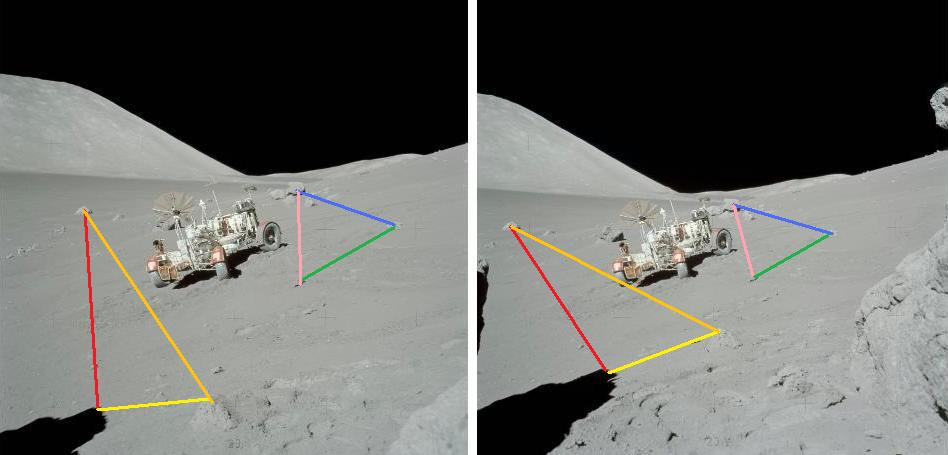 On these views, I have made two triangles with artifacts; one with the artifacts of the upper part of the photo, and one with the artifacts of the lower part of the photo. And you can see that, whereas the triangle of the upper part shows hardly any rotation, the triangle of the lower part shows an important rotation.  You can also see that the distance of an artifact (which was close to us on the first photo) to the rover changes importantly, much more than the size of the rover. 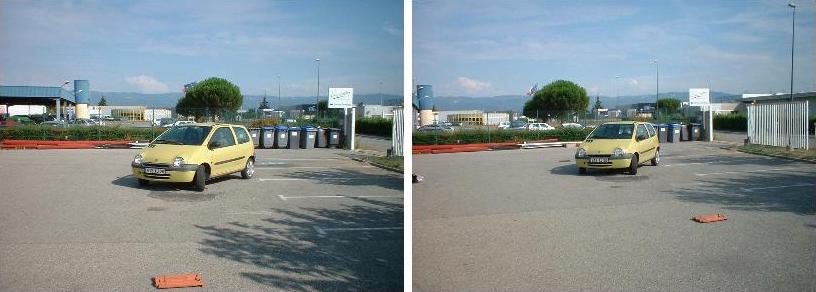 I have made a little reconstitution, with my car symbolizing the rover, and a tile representing the stone I indicated on the Apollo photos. And you can see that, unlike the rover, my car shows a rotation, and that its size decreases more on the second photo (whereas in fact the tile is a little less close to the car than the stone to the rover on the Apollo photo). |
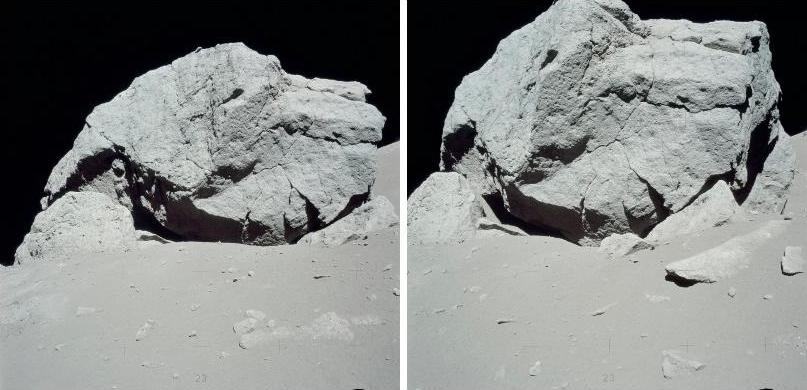 On photos AS17-140-21436 and AS17-140-21438, we have two views of a big rock. Between the two shots, the rock rotates. 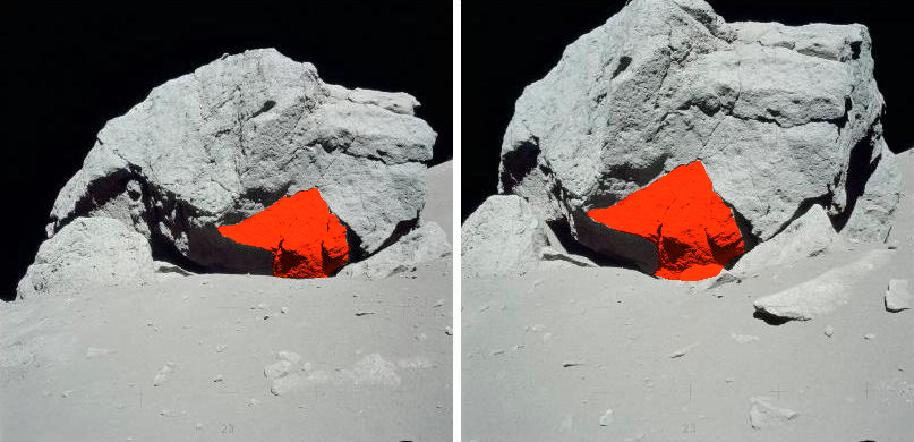 What's remarkable is that there is a part of the rock, that I have colored in red, which shows no rotation, although it rotates with the rest of the rock. On this animation, we see the rock which rotates, with the part which doesn't rotate, and only makes a translation. |
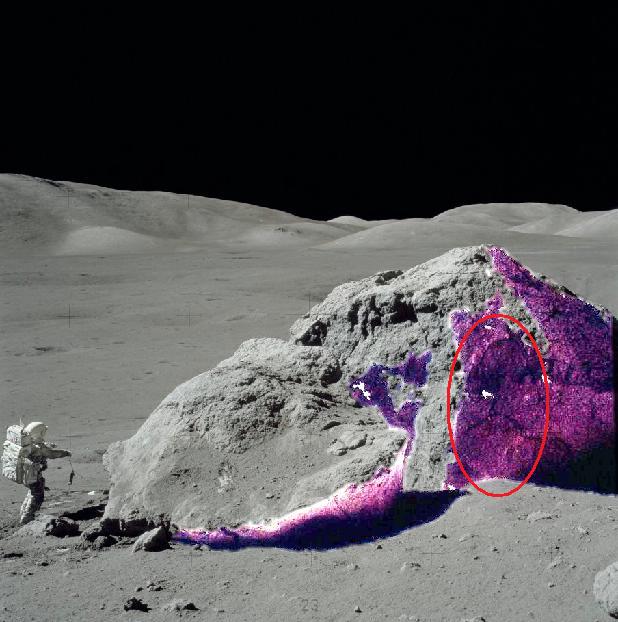 On photo AS17-140-21496, if we light up the shadow of the rock, we see a strange face appear. |
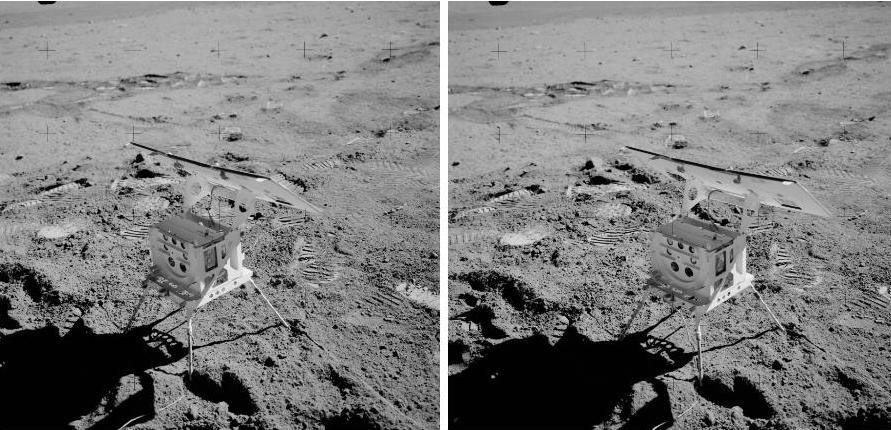 On photos AS17-141-21510 and AS17-141-21511 we have two views of the SEP transmitter.  But, if we take a close-up, we can see holes (I have circled in red) on the first view which appear much bigger than on the second view; yet the perspective doesn't appear so different. 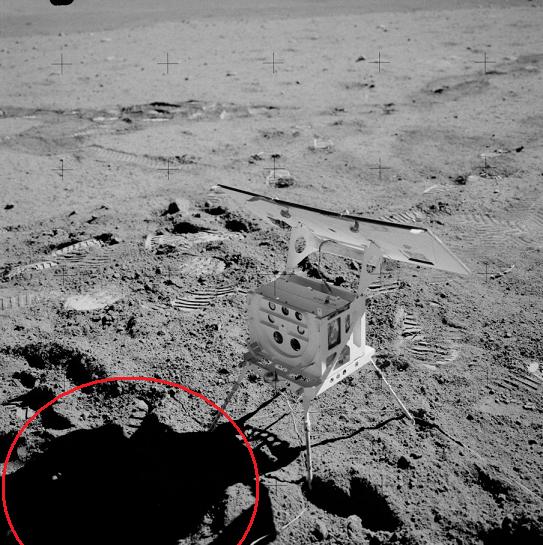 But in fact this is not the strangest part. The strangest part is the weird shadow of the SEP transmitter. It's outright impossible; and it can't be the shadow of something which is placed behind the photo because of the orientation of the shadow. |
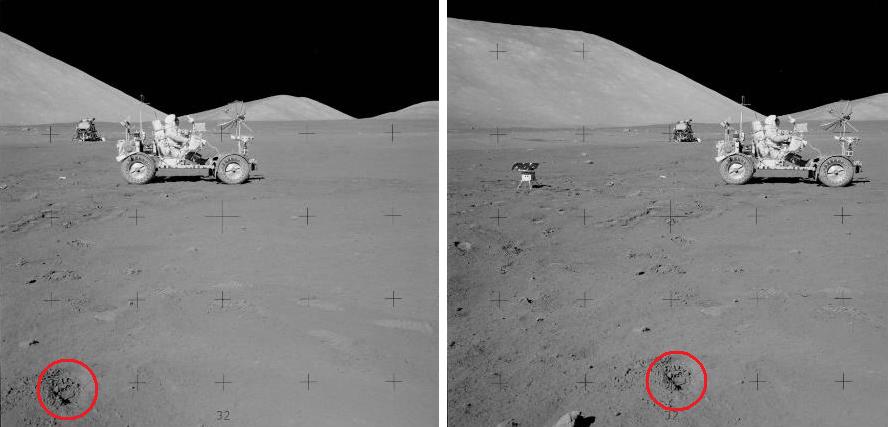 On photos AS17-141-21512 and AS17-141-21513, The photographer turns his camera on the left, but he also moves a little on the left: Indeed, we can see that the hole in the close foreground has moved on the right relatively to the background. 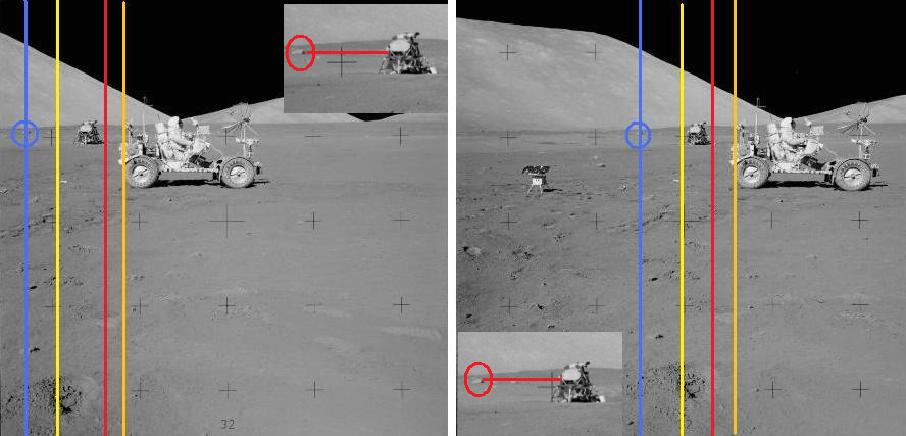 The rover has also moved slightly on the right relatively to the lem and the hills, but of course less than the hole in the close foreground. But there is a rock which is farther than the lem which has also moved on the right relatively to the lem; yet, as it is farther than the lem, it should have moved on the left instead (relatively to the lem), or at least not moved if the lem is far enough not to react to the move of the astronaut. 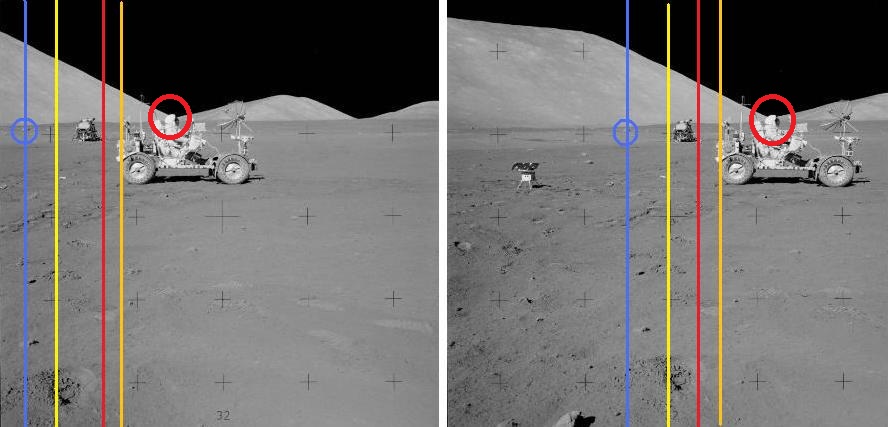 And also the head of the astronaut is exactly on the bottom corner of the hills in the background; on the second photo, it should have moved on the right relatively to this bottom corner. |
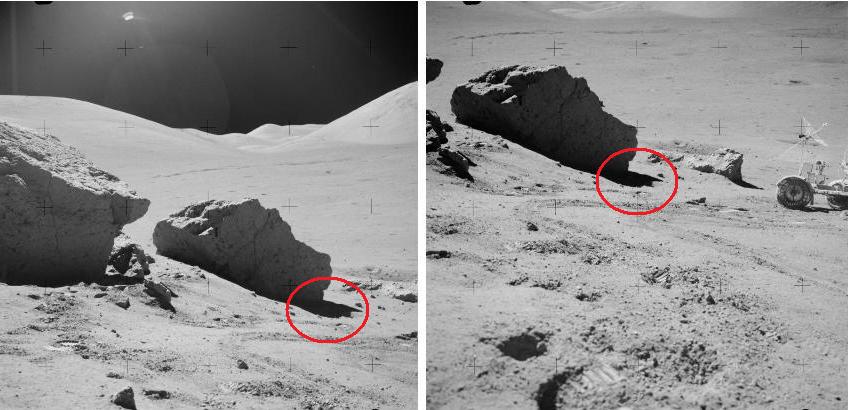 Here on AS17-141-21596 and AS17-141-21597, we have the same condition of sunlight and the same perspective, and yet the shaded parts of the rocks appear darker on one photo than on the other. Apollo fans have told me that the photos could have been taken at very different moments (although their sequence numbers are close), and that therefore the sunlight could have changed between the two photos. But it's easy to go around this argument; look at the rock's shadow on the two photos: it has exactly the same size and orientation on the two photos; this undeniably proves that the sunlight has not changed! |
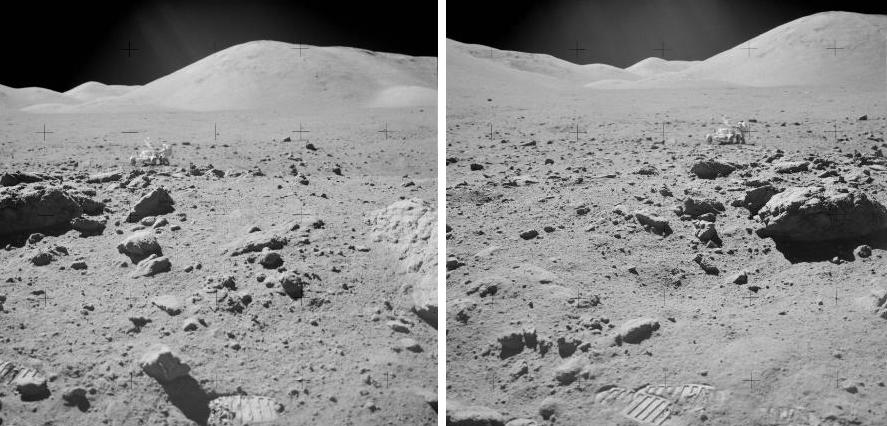 On this pair of photos in Apollo 17 (AS17-142-21825 and AS17--142-21826), the photographer takes two views of a big rock with other rocks behind and the rover in the background. On one photo the big rock is on the extreme left, and on the other one it is on the extreme right because apparently he turned his camera. 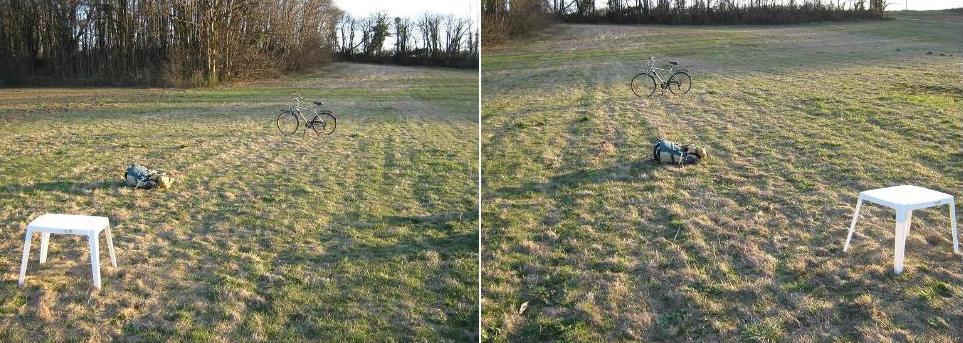 On this double view, I take two photos of a little table with my rucksack behind, and my bike still behind. The table represents the big rock in the Apollo photo, the rucksack a rock which is behind the big rock, and the bike the rover. On the first view, the table is on the left, and on the second view it's on the right (like the big rock on the Apollo photo). Between the two views, I have moved on the left; this is visible because my rucksack and my bike have moved on the left relatively to the table (my bike more because it is farther). Consequently the table shows an optical counterclockwise rotation. 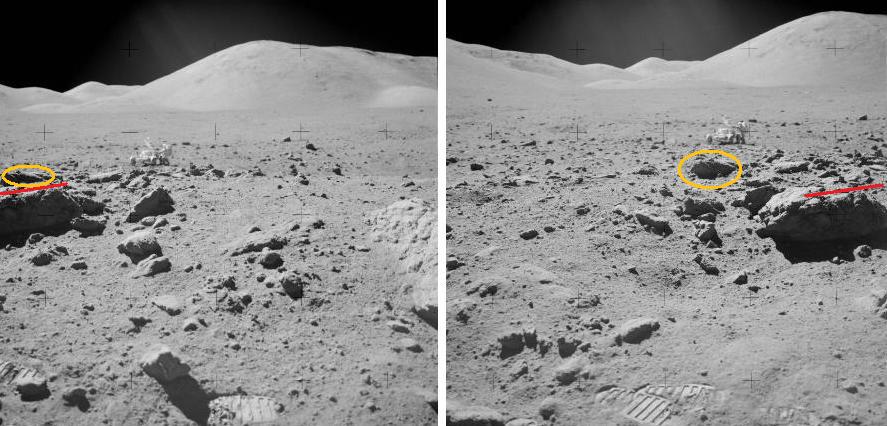 On the pair of the Apollo photos, a rock (I have circled in orange) and the rover (circled in yellow) have moved on the left relatively to the big rock, like in my example. Consequently the big rock should show an optical counterclockwise rotation in reaction to the move of the photographer, and at first view it does. So where is the problem? 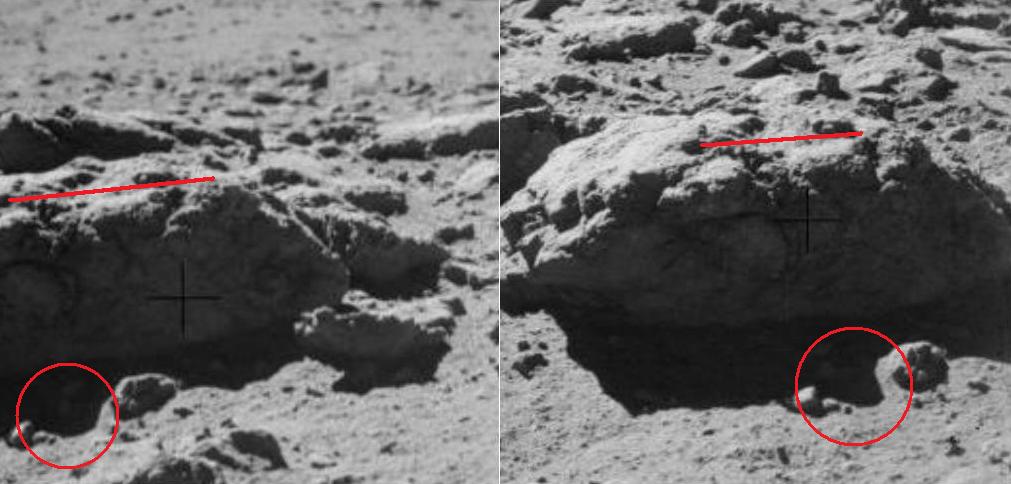 The problem is that I can find two artifacts on the big rock that, when I draw a line between them, this line doesn't show the counterclockwise rotation it should, and even a slight clockwise rotation. Another anomaly is that the bit of shadow I have circled in red drastically changes between the two photos. 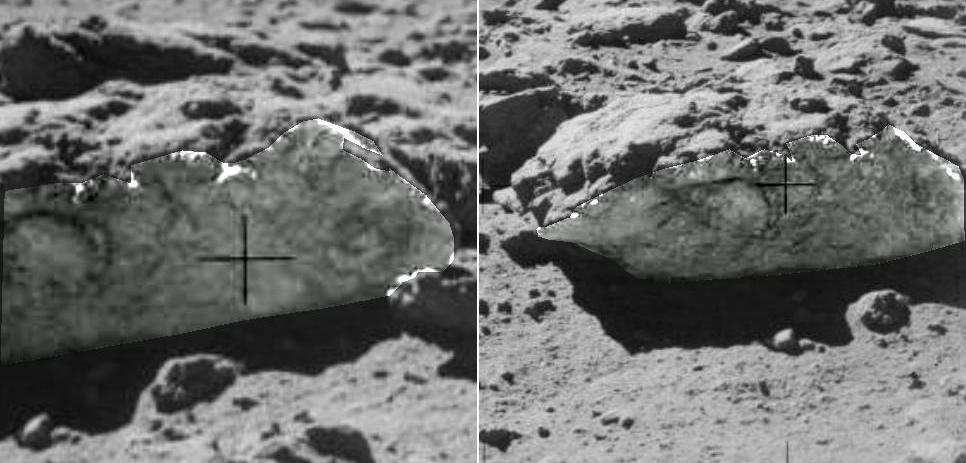 I have added some luminosity on this big rock on the two views, and we see very strange things appear on it...and they are not the same on the two views, there are differences. |
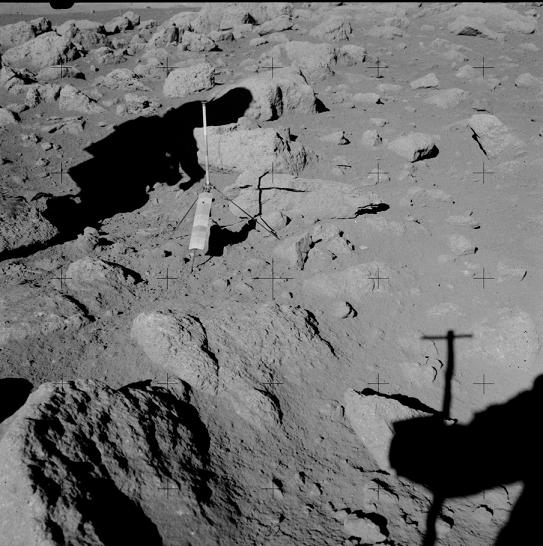 On photo AS17-133-20328, we see the shadows of the two astronauts in such a way that it is obvious that none of them could take the photo. The shadow of one of them is outright delirious, funny. |
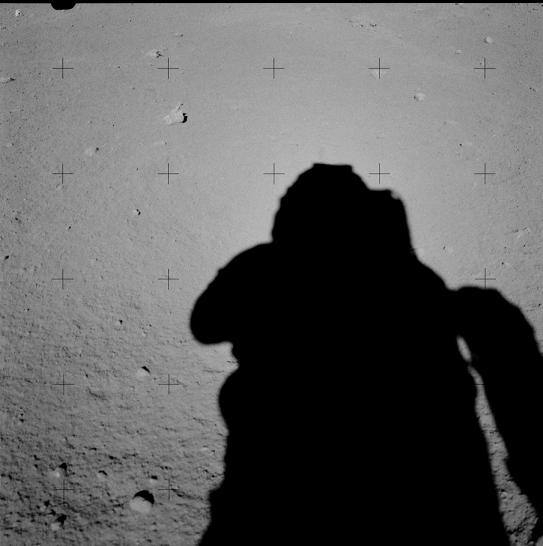 On photo AS17-133-20339, what's in the back of the astronaut? |
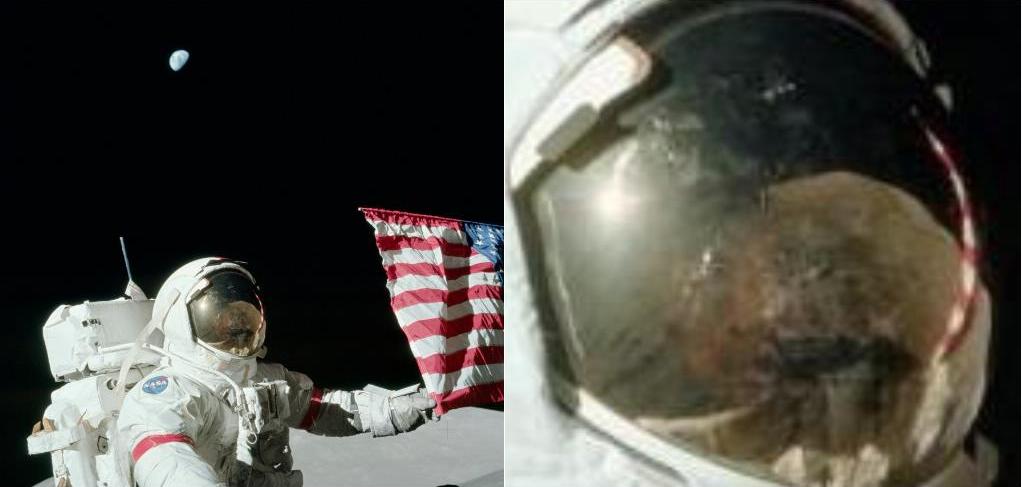 On photo AS17-134-20387, the reflection on the visor of the astronaut looks rather strange. |
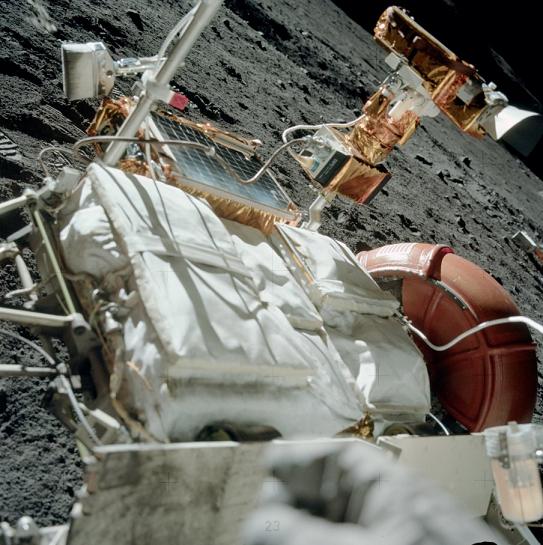 On photo AS17-134-20389, how did the astronaut manage to take that photo of the rover under this impossible angle? Note: You can see his glove on the lower edge of the photo. |
 Between photos AS17-134-20394 and AS17-134-20396, on the zone circled in red, the shadow has progressed between the two photos. Of course you could tell me: Who tells you the astronaut didn't wait for the sun's inclination to change between the two photos? Well, in that case the shadow would also have progressed in the zone circled in yellow, and it hasn't! |
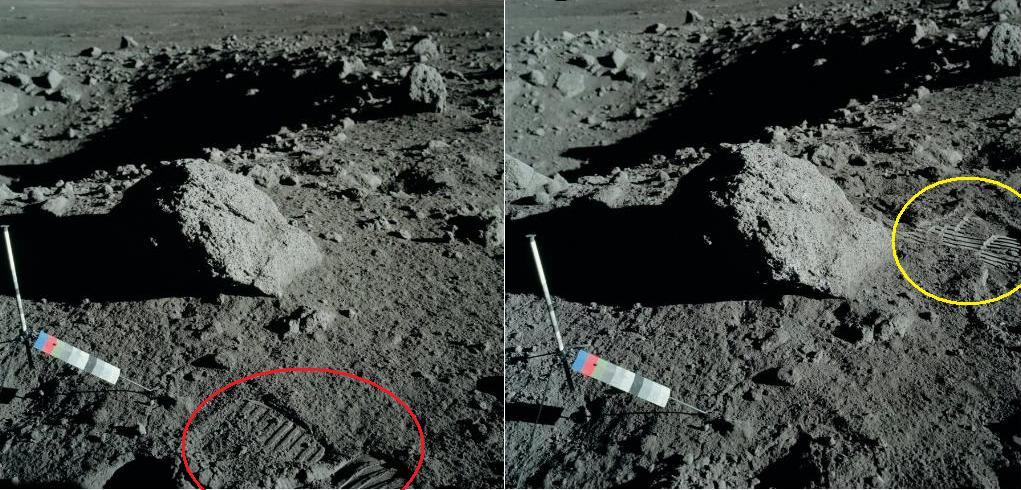 On the photo AS17-134-20399, there are new footprints (circled in yellow) which are not on photo AS17-134-20398. But the footprints which were on the photo AS17-134-20398 (circled in red) are no more on the photo AS17-134-20399. The footprints are short lived on the moon! |
 On photo AS17-134-20421, where are the other footprints which should be near the ones we see on the photo? |
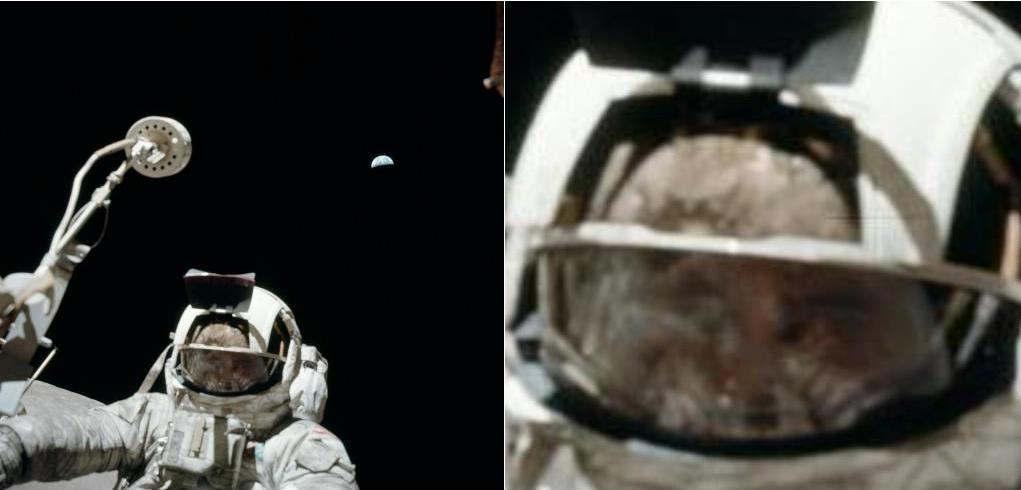 On photo AS17-134-20471, the visor looks really strange. On the lower part, we can distinctly see a dog's face with his paws on each side of it. |
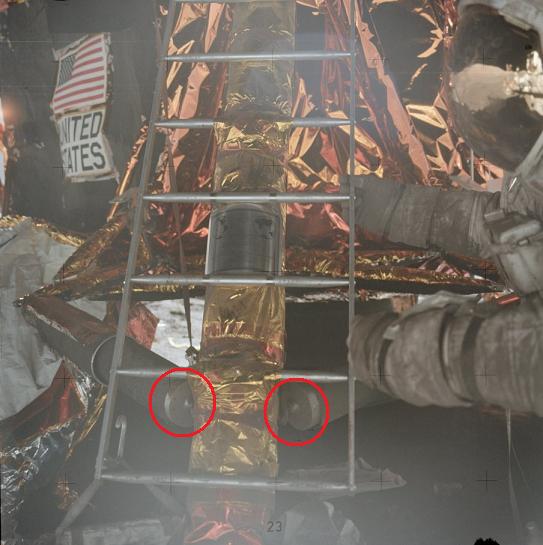 On photo AS17-134-20488, these struts are very strange. How the hell are they articulated? They seem to be loose! |
 On the photo AS17-134-20489, we see the ALSEP in the foreground, and a rock, I have circled, in the background. On this photo, the ALSEP is facing the rock. 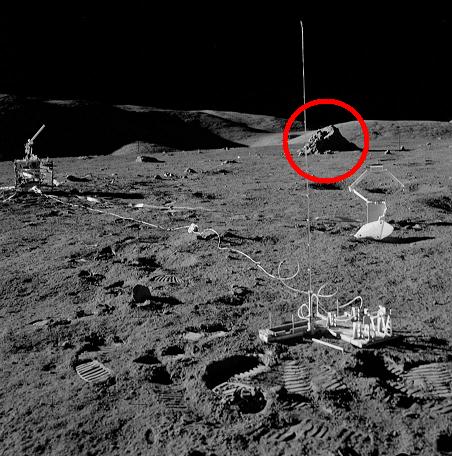 On the photo AS17-136-20704, we also see the ALSEP and the same rock I have circled. We can see that the Alsep and the rock are viewed under a different angle, for they were vertically aligned on the previous photo, which is no more the case on this view. If we compare the ALSEPs of the two views, they appear to be different. 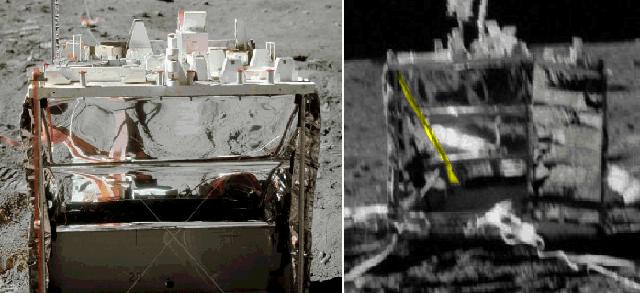 In particular the cable I have highlighted in yellow is thicker on the second view, but it is not the only difference. Look at the items which are on it: They also appear to be different. And also look at the rocks of the two photos. They are not shadowed the same. 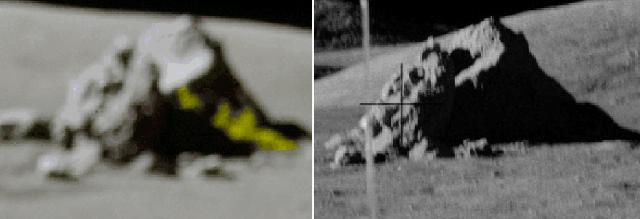 The shadow of the rock of the first photo contains clear parts I have highlighted in yellow. I know what you are going to say: It is because the orientation of the sun is not the same on the two photos. On the first photo, the sun would be shining on the side of the rock, and, on the second photo, it would be shining on the back of it. 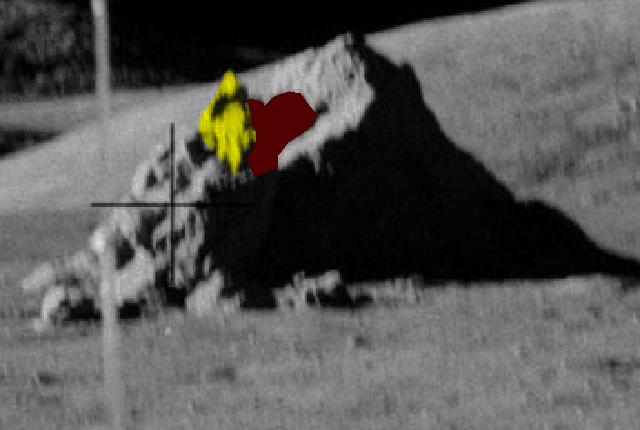 But, if the sun is shining on the back of the rock in the second photo, then why does the bit I have highlighted in yellow produce the shadow I have highlighted in red? 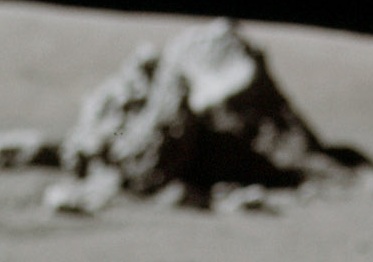 We don't even see this shadow on the rock of the first photo! 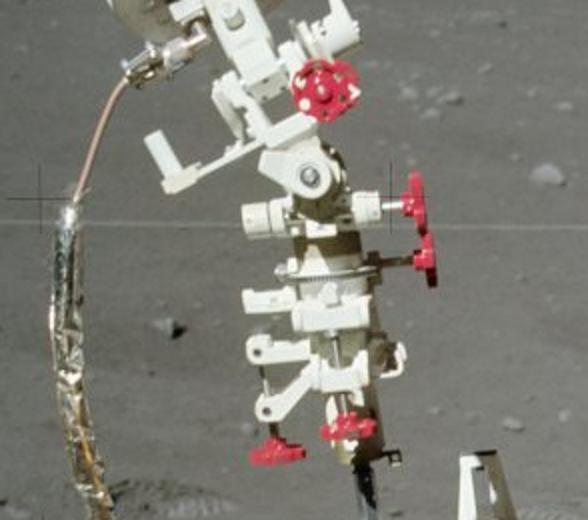 Furthermore, on the moon, as much as I know, the space if 3D like on earth. So, to orient the antenna, they only need to turn the antenna around three axes, and, in order to do that, they normally only need three adjustment knobs. So, why do we see five adjustment knobs? 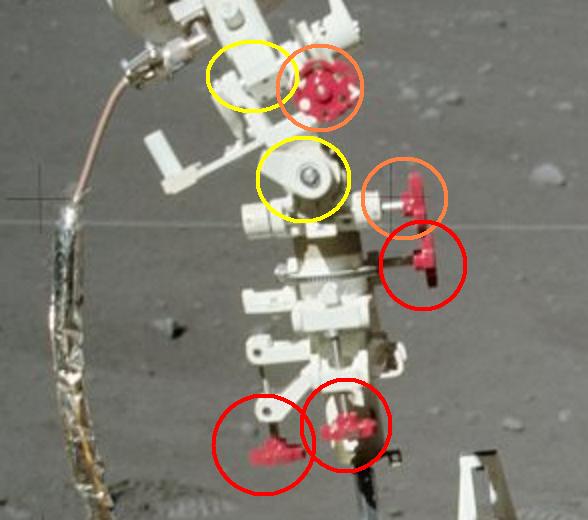 The two knobs I have circled are most certainly useless and redundant...which does not mean that the other ones really allow to orient the antenna! |
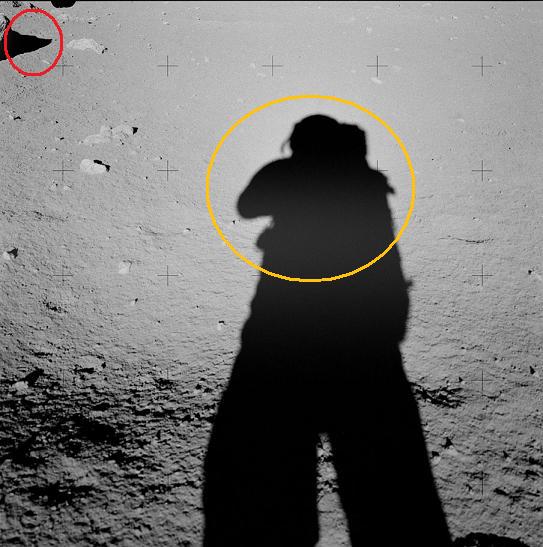 On photo AS17-136-20684, the shadow of the astronaut is not far from the middle of the photo; therefore he is seen too much in profile, his profile should be slighter. The shadow of the rock is incorrect; it is too horizontal. |
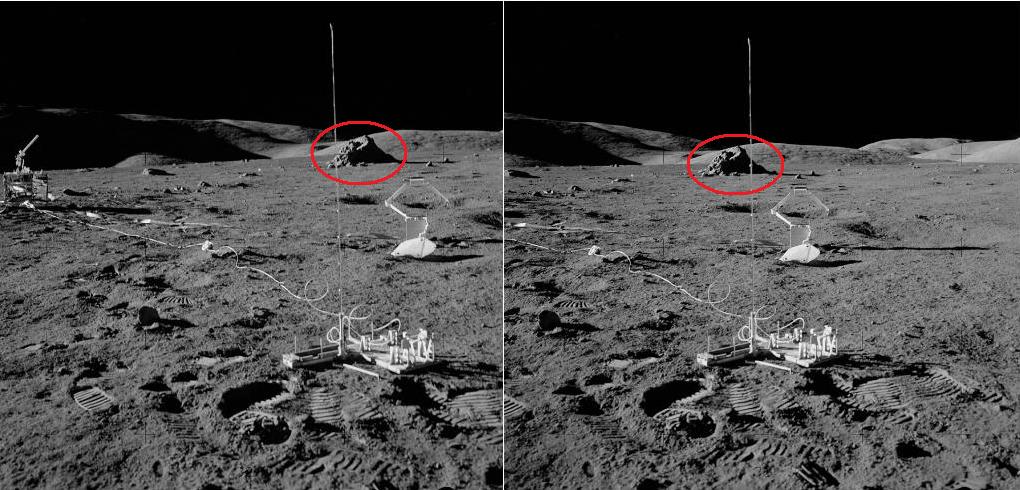 Between photos AS17-136-20704 and AS17-136-20705, the photographer turns his camera on the right, but he also moves the left; it's visible because the antenna of the ALSEP moves on the right relatively to a rock in the background. 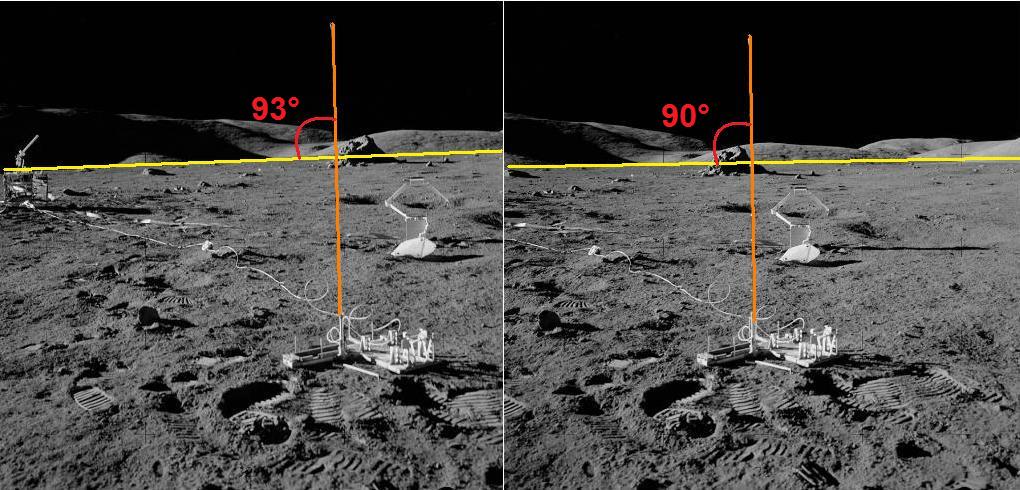 Logically, as the photographer has moved on the left, the antenna of the ALSEP should have rotated clockwise relatively to the horizon line; but it's the converse, it has rotated counterclockwise! |
This is an animation made with the photos AS17-136-20716 and AS17-136-20717. On it you can see that the lower part makes a clockwise rotation while the upper part makes an counterclockwise rotation! |
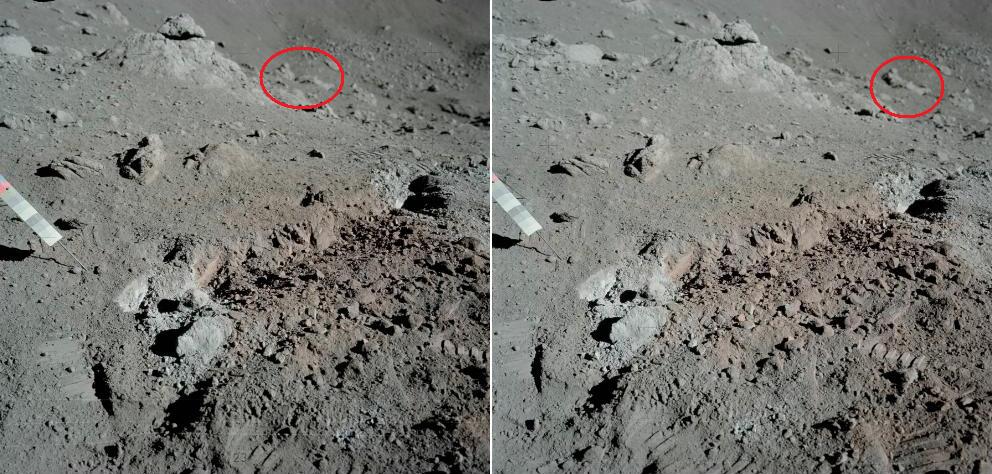 There is a weird rock (I have circled in red) which is different on photos AS17-137-20985 and AS17-137-20986. |
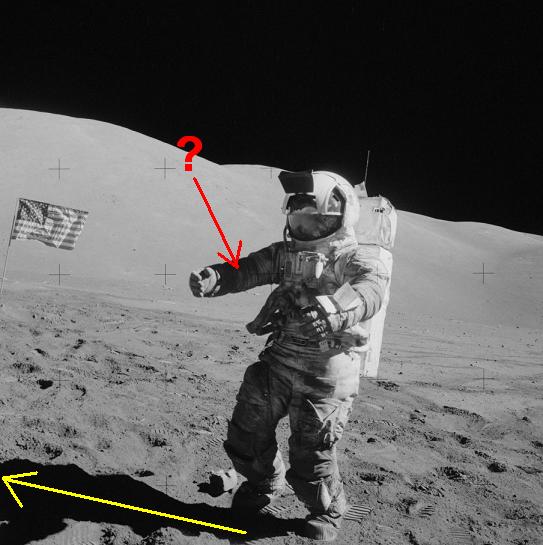 On photo AS17-143-21941, by the direction of the astronaut's shadow we know the direction of the sunlight; thence the inner side of his right arm is obviously exposed to the sunlight, and it can't be shaded by the left arm for the astronaut is stretching his right arm higher than his left one. So how can his right arm appear shaded on the photo??? |
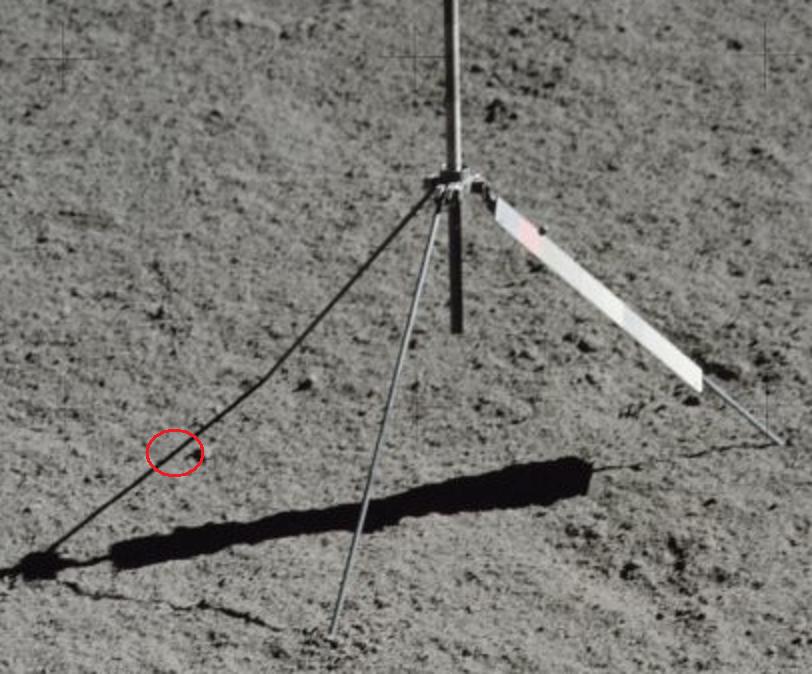 This is a close-up of the tripod we can see on the photo AS17-146-22368. What's particular on it is that there is a leg of the tripod which has a much too perfect shadow (that I have circled). Normally this shadow should be disturbed by the relief like the other shadows, but it's absolutely not disturbed, it's like it was drawn with a rule; this shadow is completely unrealistic! moreover there is no footprint near the tripod; how did the astronaut do to put the tripod without leaving a single footprint? |
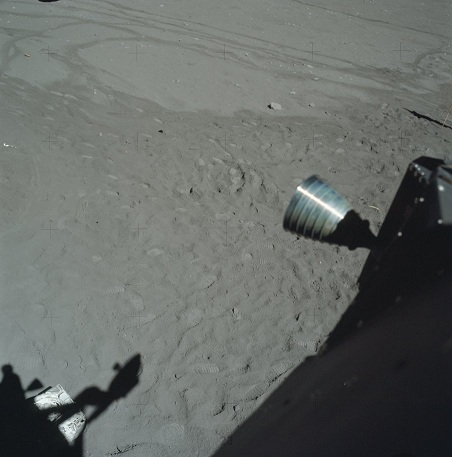 The photo AS17-145-22213 has been taken through the LM's window. On it, we can see the shadow of the radar antenna on the left bottom, and the flag's shadow on the top right; we don't see the flag itself completely, but we can see the bottom part of its flagpole. The directions of the shadows of the antenna and the flag are very different, but however it is not an anomaly. Indeed, you can find on the net photos of moon hoax debunkers showing unparallel converging shadows. However, these photos show a common fact: The directions of the shadows always meet on a common point, including the photographer's shadow (and the photographer's shadow is always vertical when the camera is held horizontally). 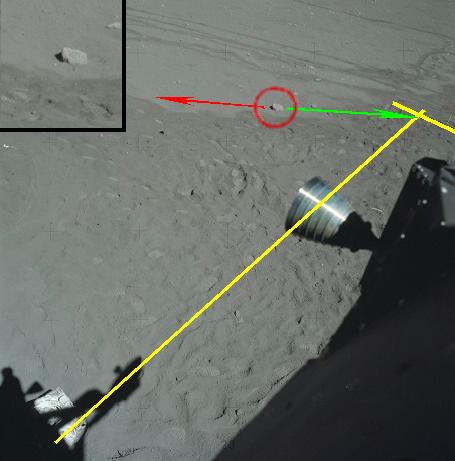 On the photo, we can see a little rock I have circled; I show a close-up of it on the top left of the photo. Logically the shadow of this rock should be oriented toward the point of intersection of the directions of the shadows of the antenna and the flag...instead of that it is oriented practically in the opposite direction! |
 On photo AS17-146-22402, see this series of aligned footprints; the astronaut jumped like a kangaroo. Seriously, in an as dangerous environment as the moon’s one, would astronauts reasonably take the chance of jumping like kangaroos, whereas the least tear of their suit caused by a pointed rock could mean their death? |
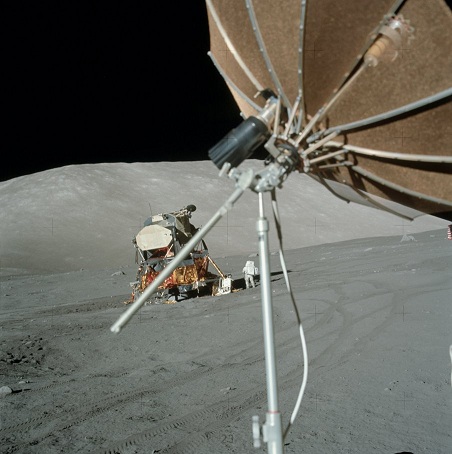 In Apollo 17, there are plenty of photos on which the lunar module is visible, but I'll retain three of them. This one, AS17-134-20447. 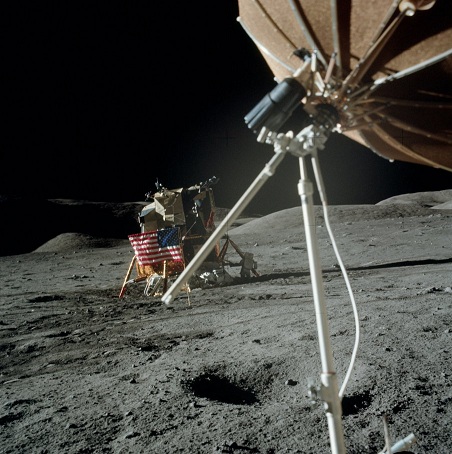 This one, AS17-134-20448. 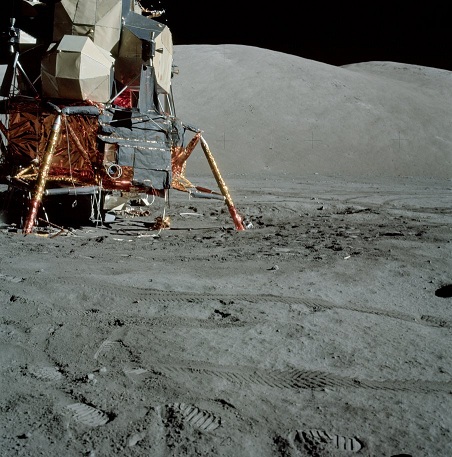 And this one, AS17-137-20874 (with the following one, AS17-137-20875). Now, let's compare the two first photos, AS17-134-20447, and AS17-134-20448. On them the lunar module is seen under different angles. I have circled in yellow the same leg on each of the views. On the second photo (right of the double view), I have circled a hole which is close to the lunar module. On the first photo (left of the double view), I have circled the corresponding region in which we should see the same hole...but we don't find it in this region. Of course, I have looked on the high definition version of the photo. Now let's compare the photo AS17-134-20447 with the photo AS17-137-20874. On these photos the lunar module is also seen under two different angles. I have circled in yellow the rear panel of the lunar module on the two photos; and I have circled in orange the leg which is under this panel. I now use the following photo, AS17-137-20875; I have circled on it, in yellow, the same leg, and, in red, a rock which is close to the lunar module. On the first photo (left of the double view), I have circled in red the region in which we should find the same rock...but we don't find it in this region! Of course, I have also looked on the high definition version of the photo. We find a rock not far, but, not only it is not positioned the same relatively to the lunar module, but furthermore it is also shaped differently. |
When the photographer simply turns his camera without moving, the foreground and the background move the same; an object in the foreground will not move relatively to the background, and shows no rotation either. The white van on the parking lot does not move relatively to the house in the background, and shows no rotation either. But, on the other side, if the photographer moves, the objects in the foreground will move relatively to the background on one hand, and will also show a rotation on the other hand. On the photo of the left, I am taking a photo of my bike before cars; on the photo of the right, I have moved right, and the bike moves left relatively to the cars and the grid behind, and also shows a rotation. On this new double view, I have manually turned my bike counterclockwise before moving on the right, and the bike on the second photo shows the same orientation as on the first photo, because the manual (counterclockwise) rotation compensates the optical (clockwise) one. From the photo AS17-134-20509 to AS17-134-20513, an astronaut takes a series of photos of the flag and the LM with a hill in the background. As he takes these photos, he gradually moves on the left; the result is that the flag moves right relatively to the LM, because it is closer to the astronaut than the LM, on one side, and that the LM itself moves right relatively to the hill because it is closer to the astronaut than the hill, on the other side. If we make an animation with close-ups of the lunar module on these photos, we can see that the lunar module shows a counterclockwise rotation, which is totally normal since the astronaut moves on the left as he takes the photos. The flag should also show a rotation, and a more important one, since it is closer to the photographer. As the flag moves as much relatively to the LM as the LM does relatively to the hill, the rotation of the flag should even be double of the one of the LM. But, if we make an animation with close-ups of the flag, the flag shows almost no rotation on it... ...at least much less consistent than the one of the LM, when it should be twice more important! |
 On photo AS17-134-20508, we find the LEM before a hill, and on photo AS17-137-21019, we find the same hill (recognizable by its artifacts), but without the LEM before. 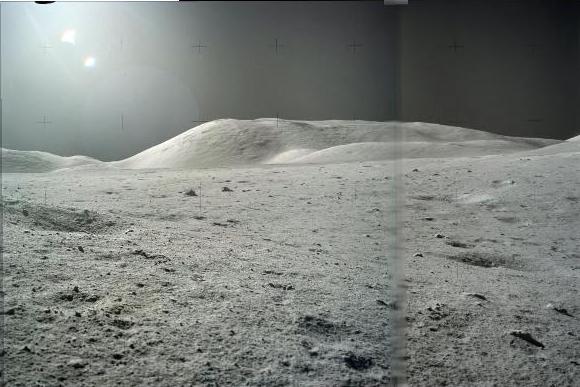 And don't think that the LEM might just be out of view on the second photo; I have made a panoramic view with two consecutive photos (AS17-137-21019 and AS17-137-21020), and no LEM in view. 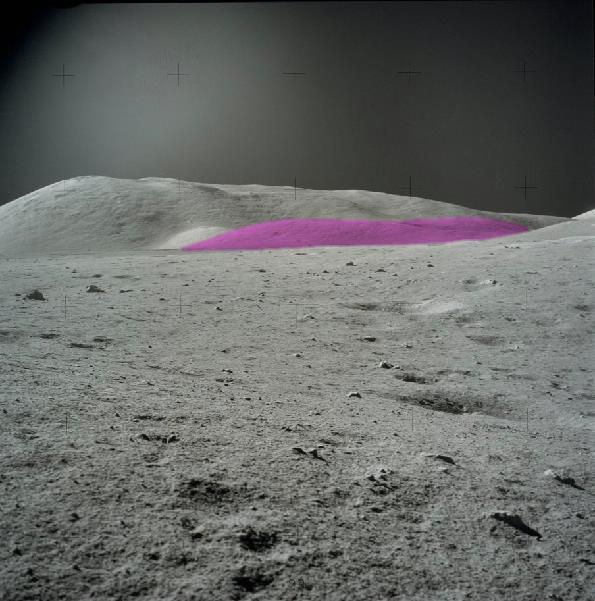 Now, you are going to tell me: Yes, it's probably the same hill, but there is a difference though; there is a little hill (I have colored in pink) before, which is not on the other photo, and the big hill behind is a little smaller than on the other photo; the lem could be hidden by this little hill. It's a possibility. 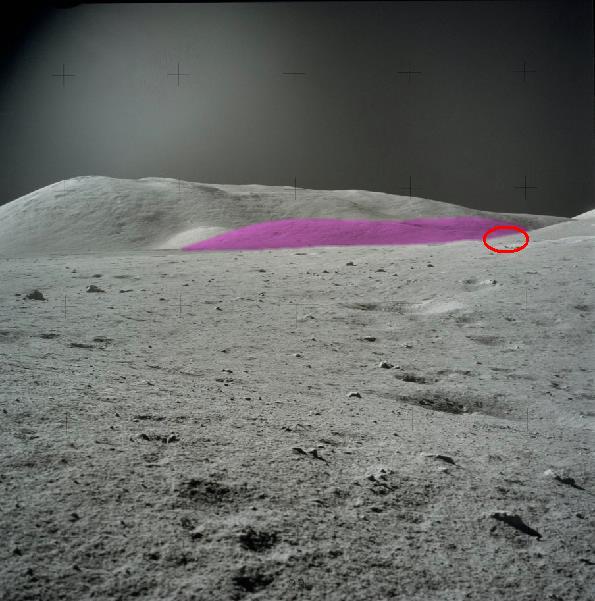 But you can see that there is a hill on the extreme right of which the foot (I have circled in red) starts before the little hill which is not present on the photo with the lem. So, logically, we should not see this hill on the photo with the lem, since we don't see on it the little hill which is after.  And yet, we see this hill on the photo with the lem (I have circled the foot of this hill in red). |
To conclude, I am going to talk about Jack white's study, and how it has been discussed, and "debunked". Jack white makes these comparisons between two photos: 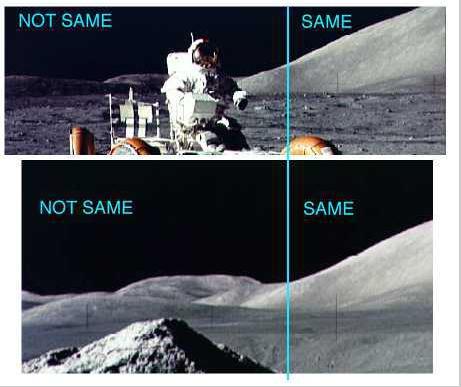 On the right of the two photos, we find the same hill, but on the left we find something different. Someone has debunked Jack White by saying that the hills on the right were in fact not the same. He has shown his study on these hills: 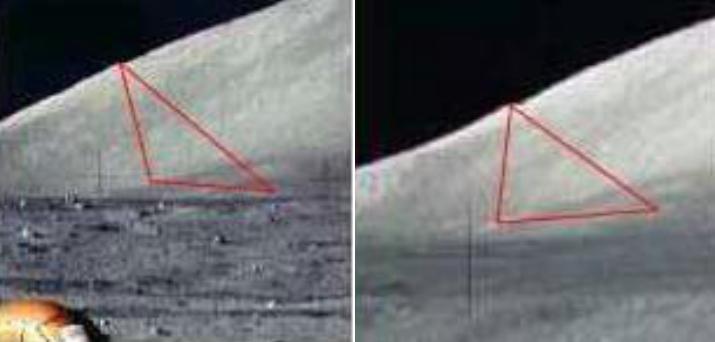 In fact, his study just shows that there is a bit of a hill which has moved on the left relatively to the other part of the hill behind. Now I take two views of a trash bin which is placed before a building; the second one is taken closer than the first one: 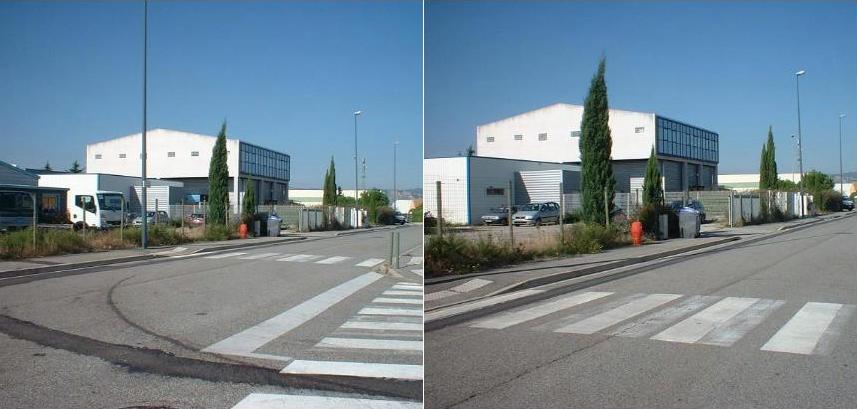 And I also show close-ups on the part which contains the trash bin: 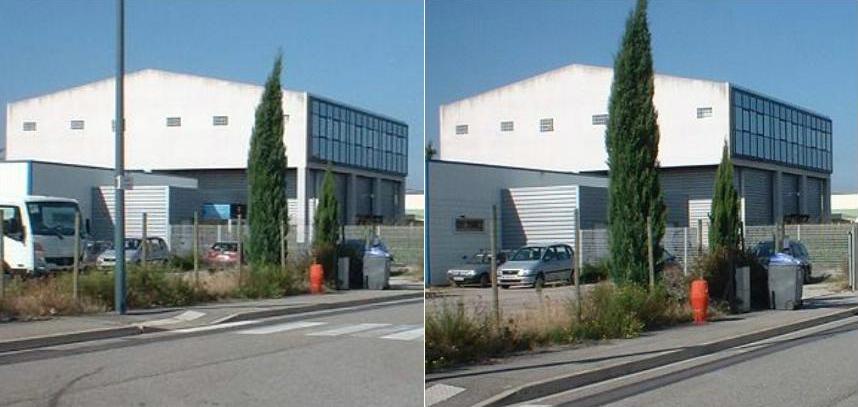 What can we see on these two views? We can see that, when I got closer to the building, the trash bin has moved on the left relatively to the building; this comes from the fact that the trash bin is closer to me than the building (and on the second view, it is also relatively bigger relatively to the building than on the first view). On the photos Jack White has shown, we can see that the first part of the hill is a little bigger on the second photo than on the first photo, and also bigger relatively to the part which is behind; this means that the photographer has got closer to the hill on the second photo, and also that the first part of the hill is closer to the photographer than the second part which is behind; consequently, it's normal that it has moved on the left relatively to the part which is behind. So the debunker is showing as abnormal something which is in fact normal, and simply results from the change of perspective; he has not shown that the hills of the two views were not the same. But, the "debunker" has debunked something which is still more interesting in Jack White's study. Jack White has associated the two photos AS17-134-20507 and AS17-137-20873: 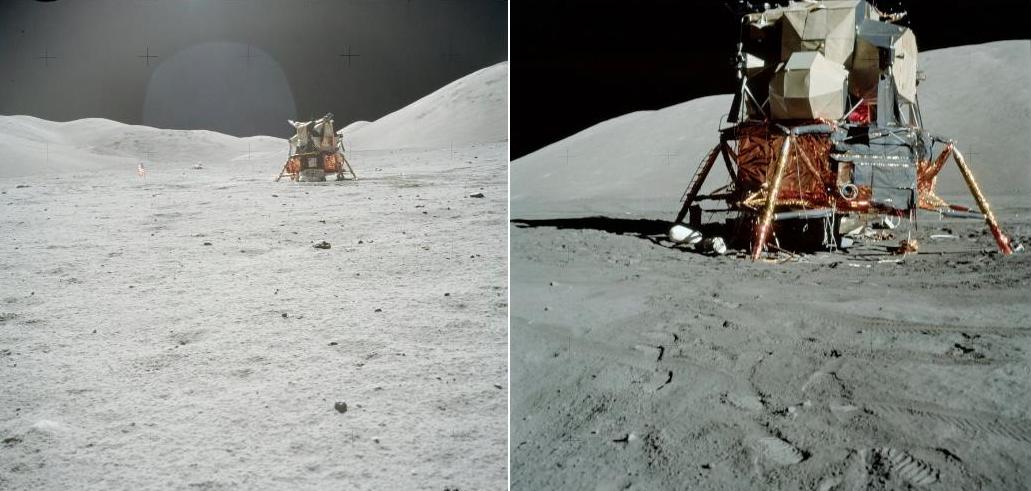 to make a panoramic which shows that the hill of the second photo matches with the hill of the first photo and prolongs it:  He deduces from it that the lem has been changed location. The debunker has said that Jack White was ignoring parallax, and that the two photos had simply been taken under two different angles; he shows this schema: 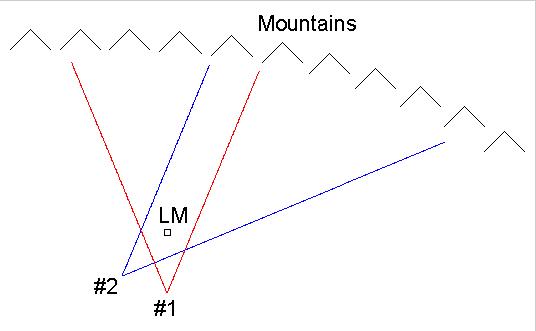 I can agree with that, but the debunker implicitly admits that, between the two photos, the photographer has turned of a little less than a quarter of a turn clockwise around the lem. So let's see now: On this double view, I show on the right a magnified view of the lem of the first photo: 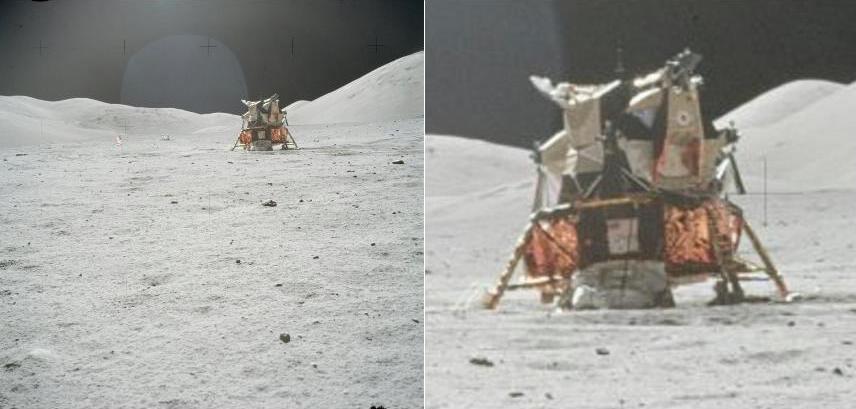 Now, let's compare with a view of the lem from above: 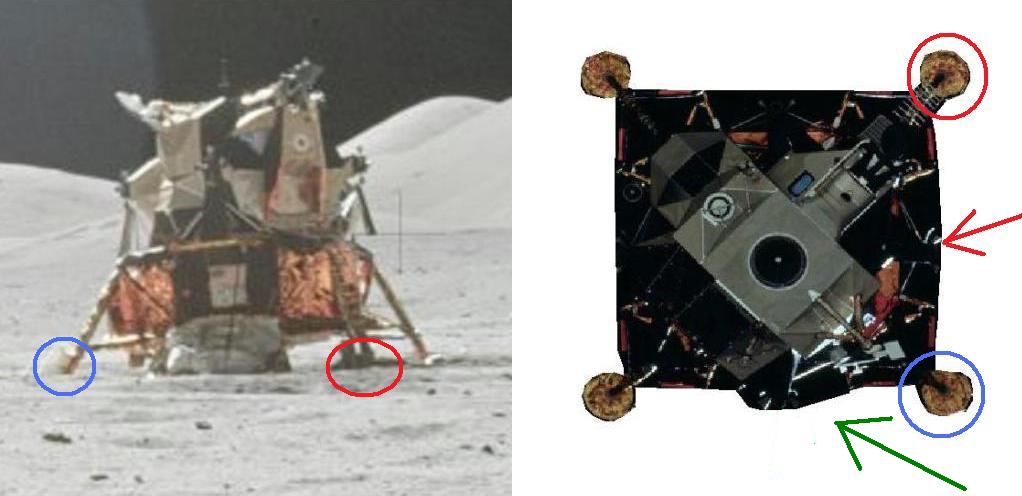 I have circled with corresponding colors feet of the lem both on the lem of the first photo and on the lem seen from above; consequently, on the lem seen from above, the direction under which the lem is seen on the first photo is indicated by the red arrow. We have seen that the photographer should turn a little less than a quarter of a turn clockwise to take the second photo, so the direction under which he should see the lem on the second photo is indicated by the green arrow on the view from above. Now, let's see the real orientation of the lem on the second photo by comparing again with a view of the lem from above: 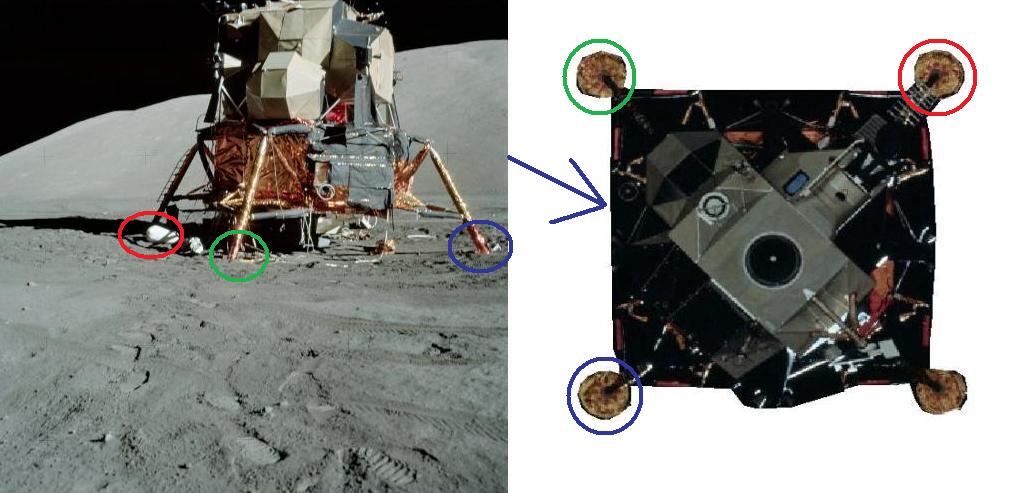 I have circled with corresponding colors feet of the lem both on the lem of the second photo and on the lem seen from above; consequently, on the lem seen from above, the direction under which the lem is seen on the second photo is indicated by the blue arrow. Now let's recapitulate the directions on the view from above: 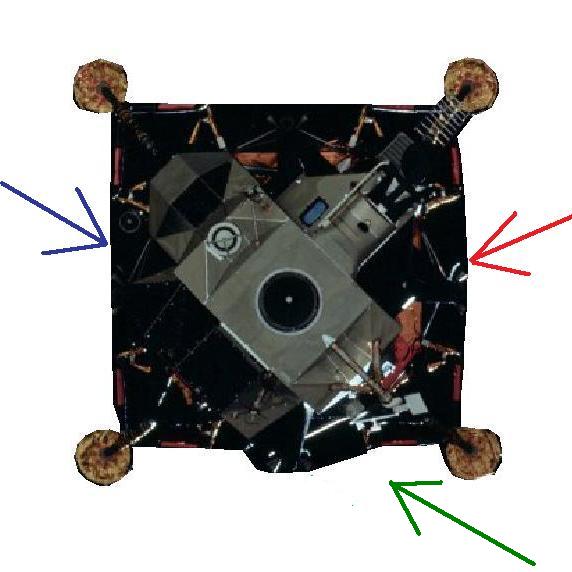 The red arrow indicates under which direction the photographer sees the lem on the first photo. The blue arrow indicates under which direction the photographer effectively sees the lem on the second photo. ...And the green arrow shows under which logical direction the photographer should see the lem on the second photo, given the direction he sees it on the first photo (red arrow); the problem is that this green arrow, instead of being close to the blue arrow, is in direct opposition to it!!! So, if effectively the two photos don't prove that the lem has been moved between the two shots, on the other hand they do prove that the lem has been turned of half a turn (or almost). Yet, it's no more plausible that the fact that the lem has been moved, for the astronauts would have had as much difficulty turning it as moving it! The debunker has just exchanged an incoherence for another one which also proves the hoax! |